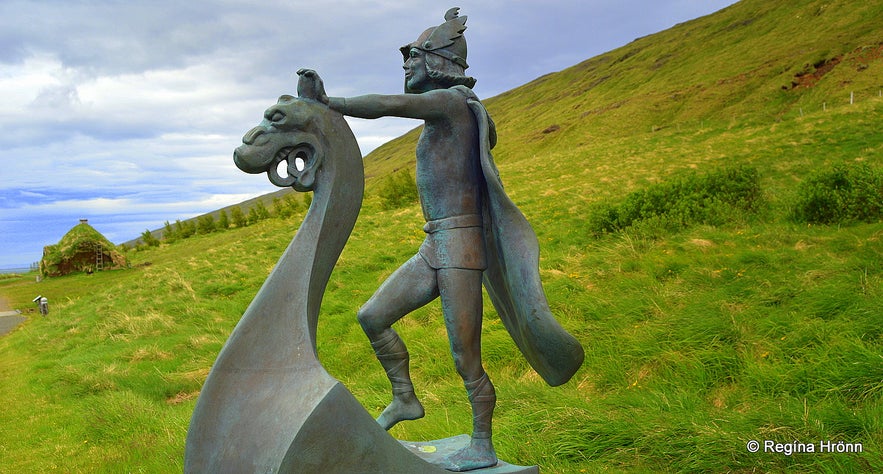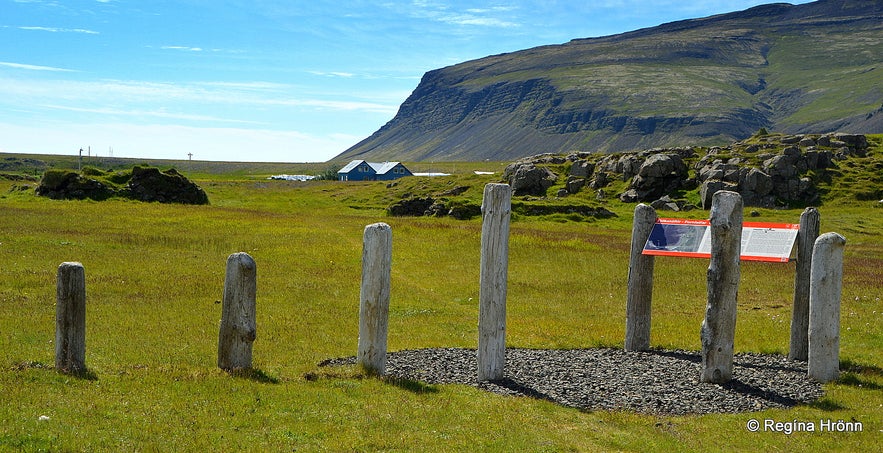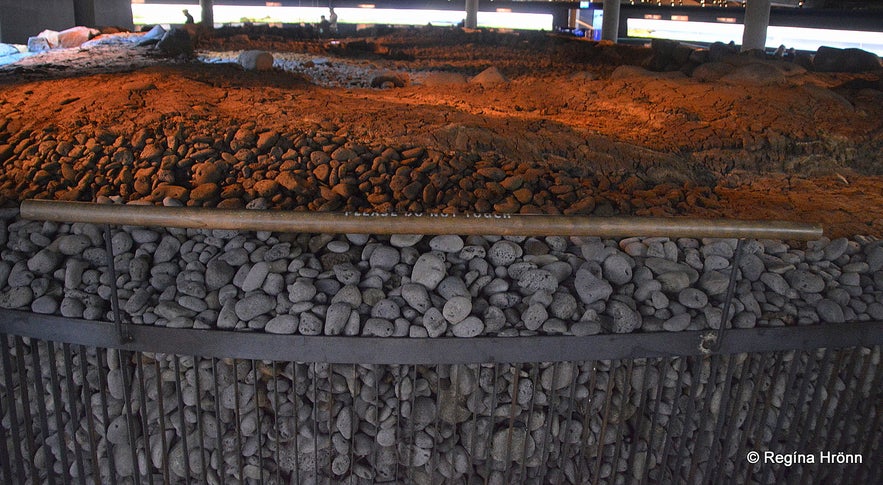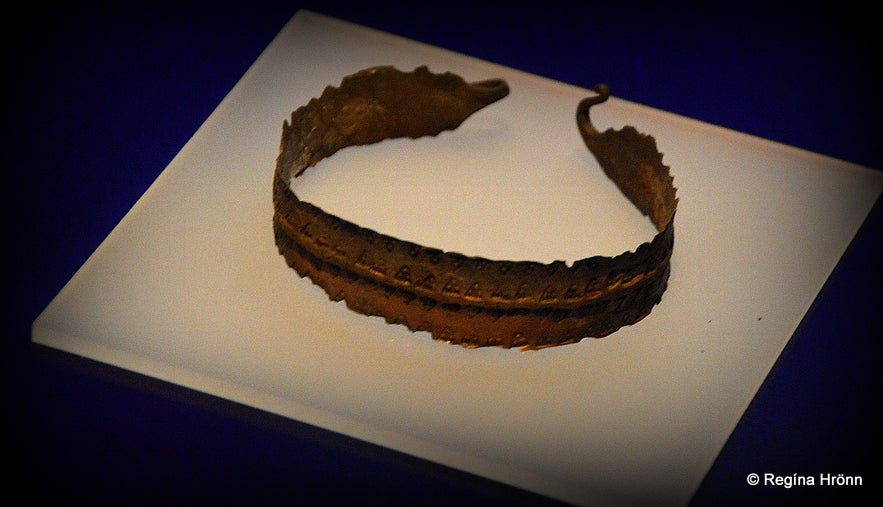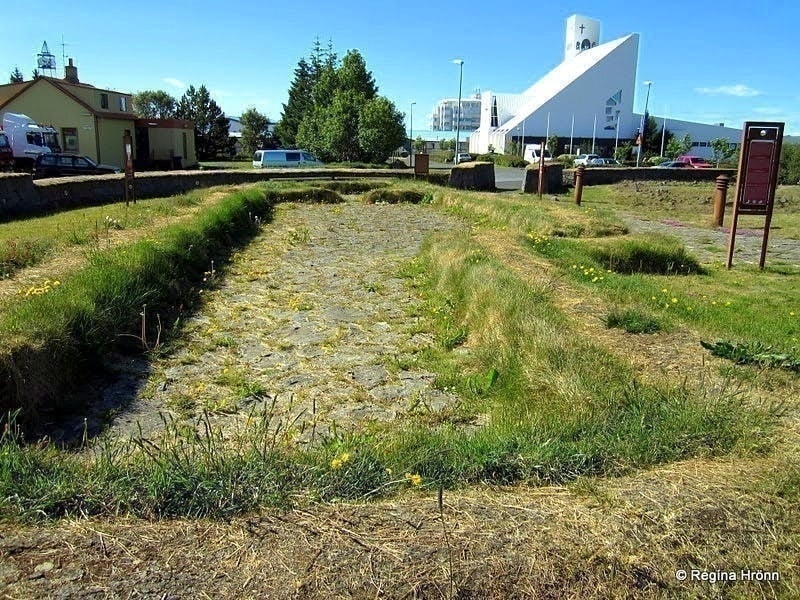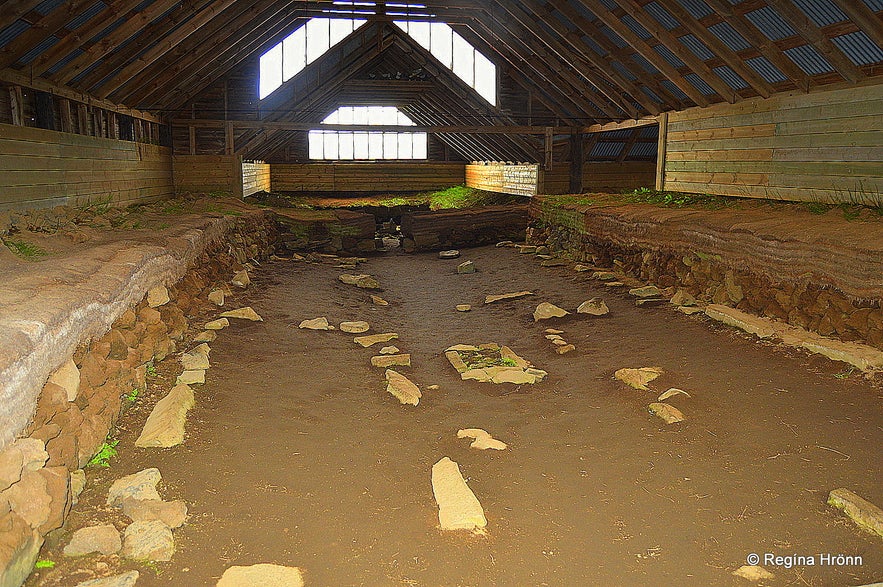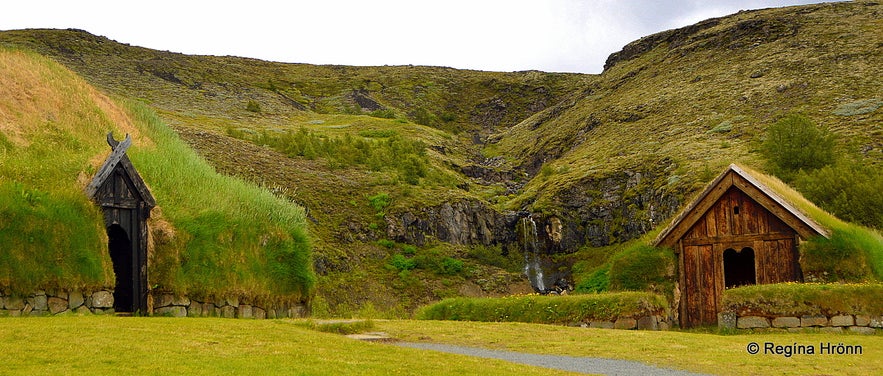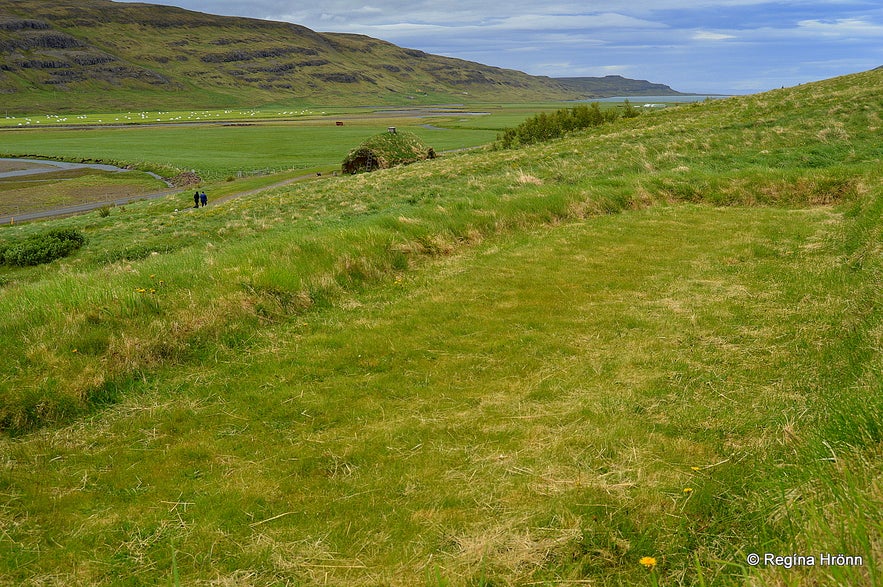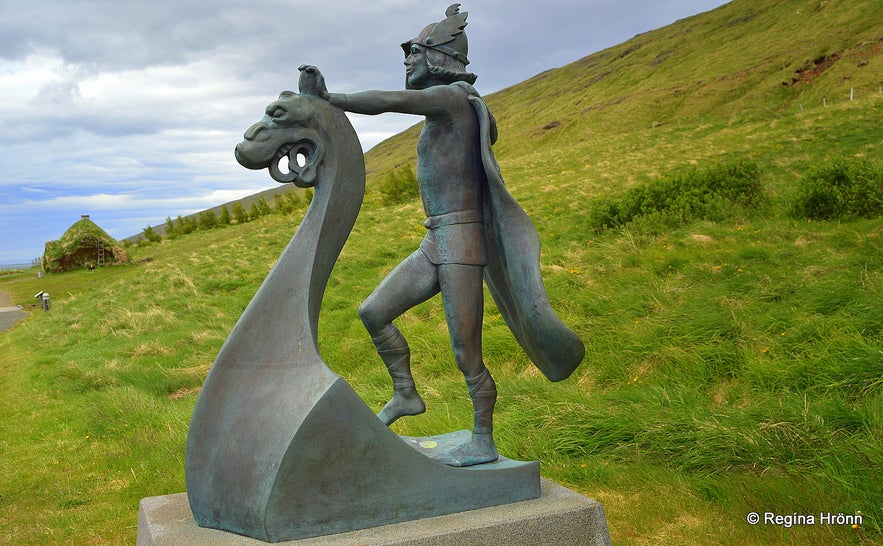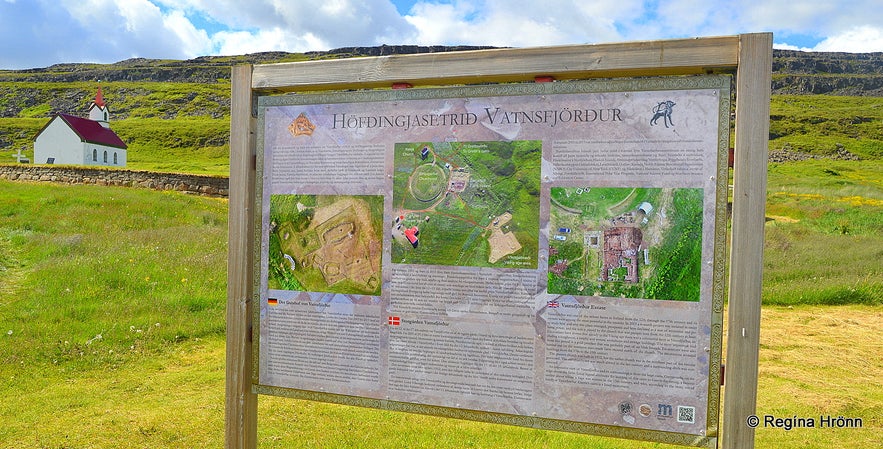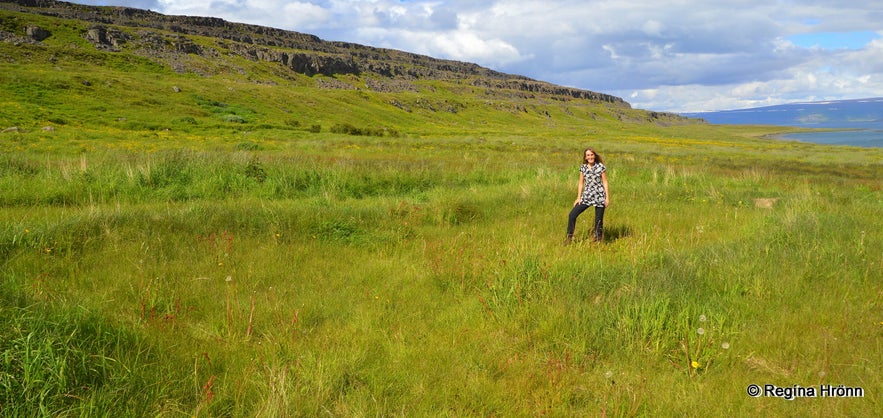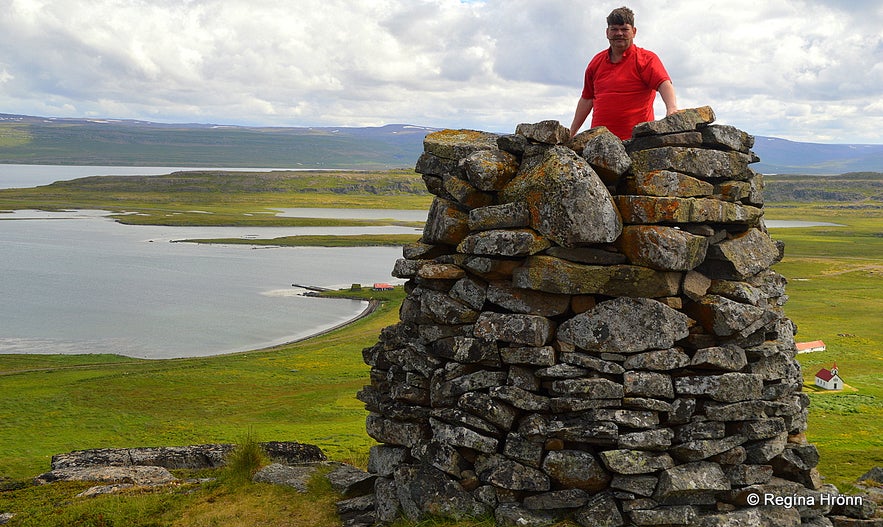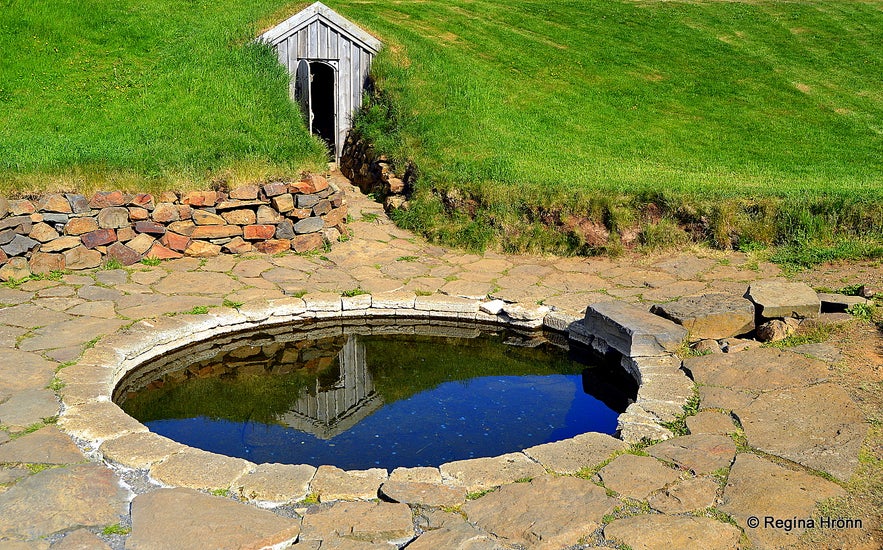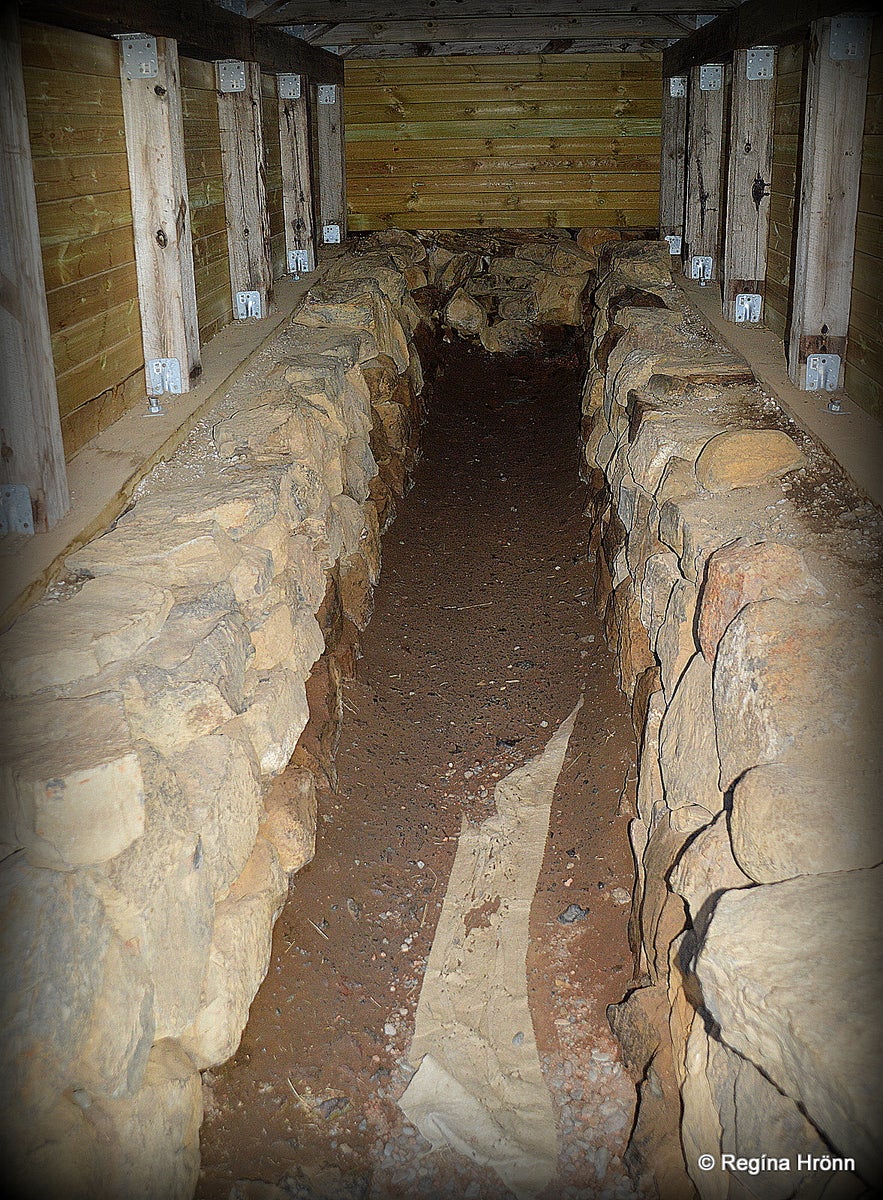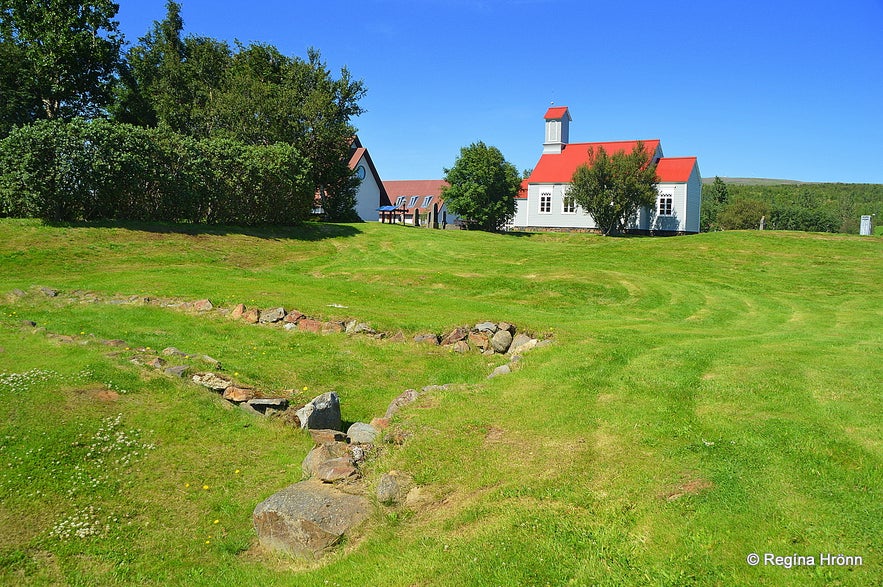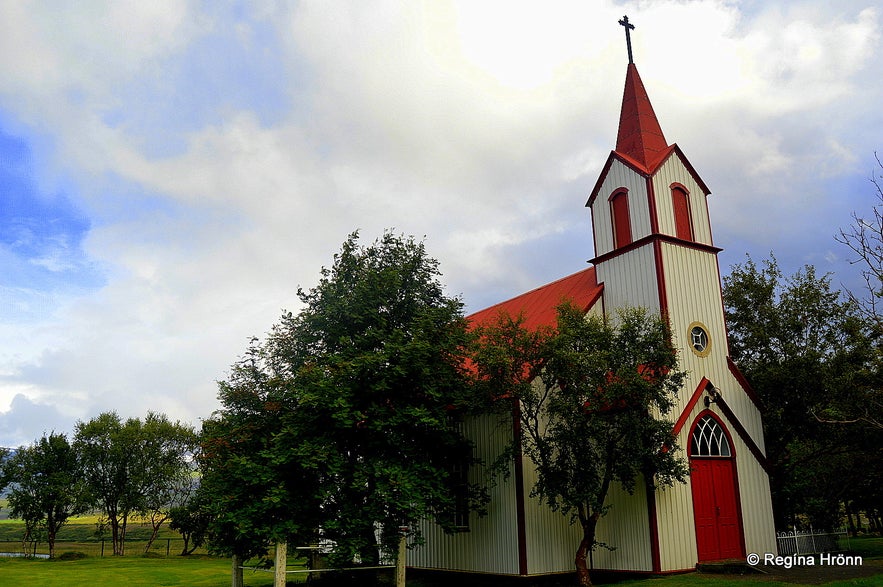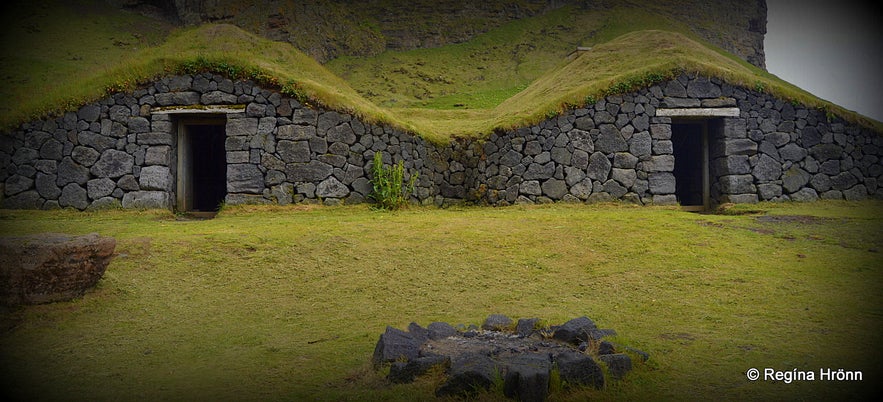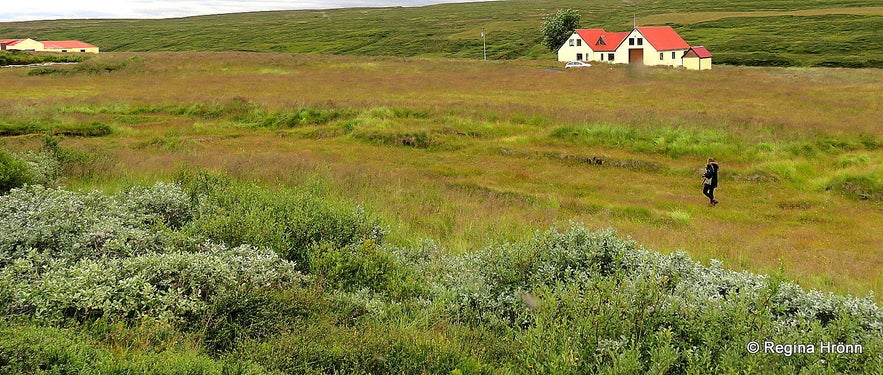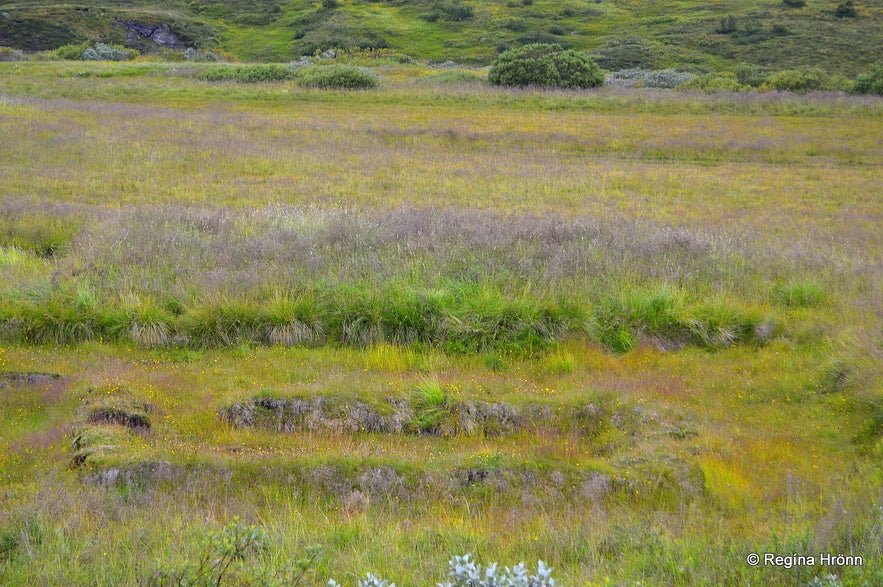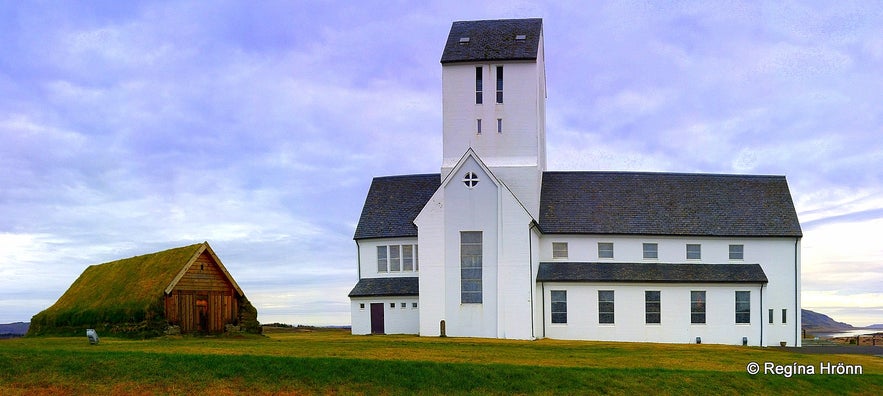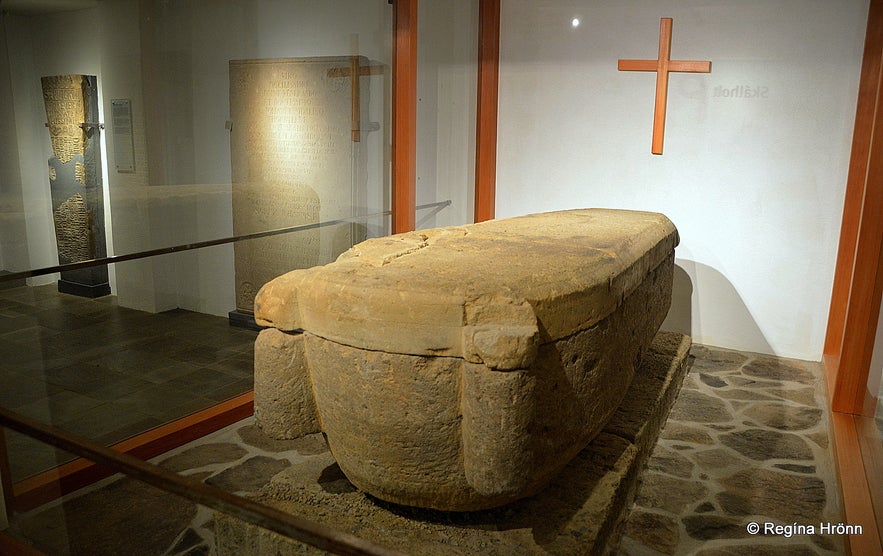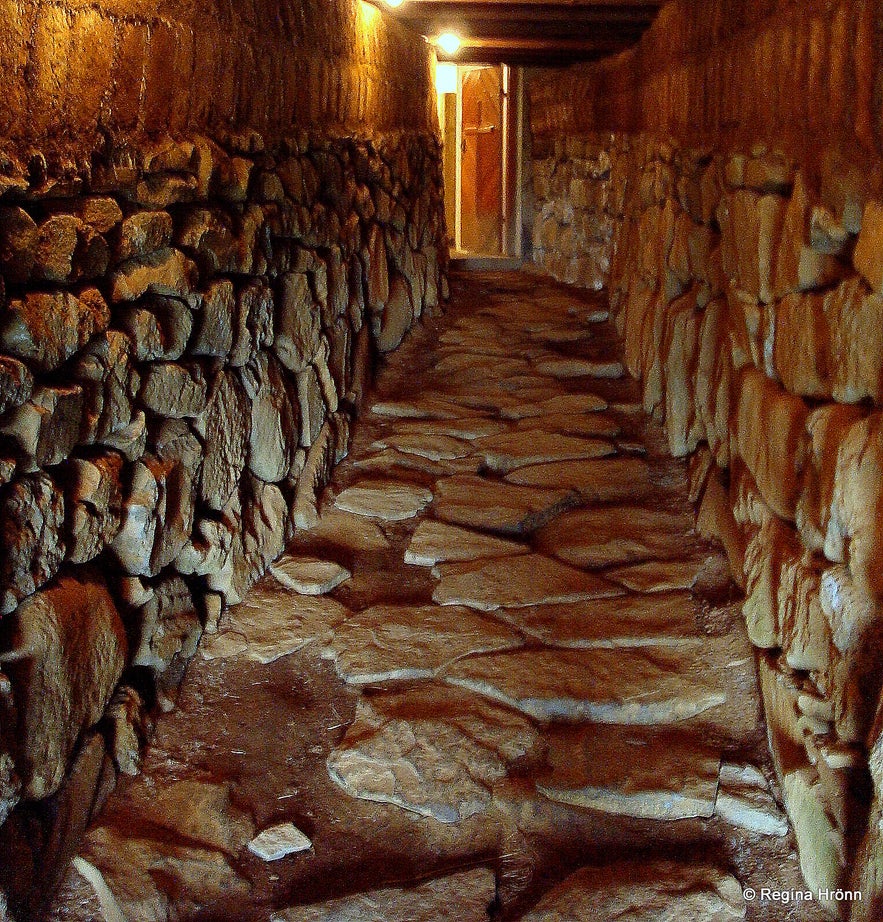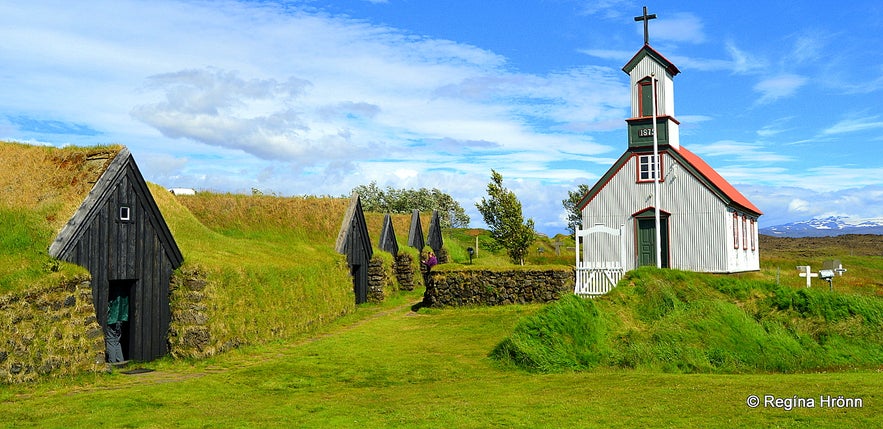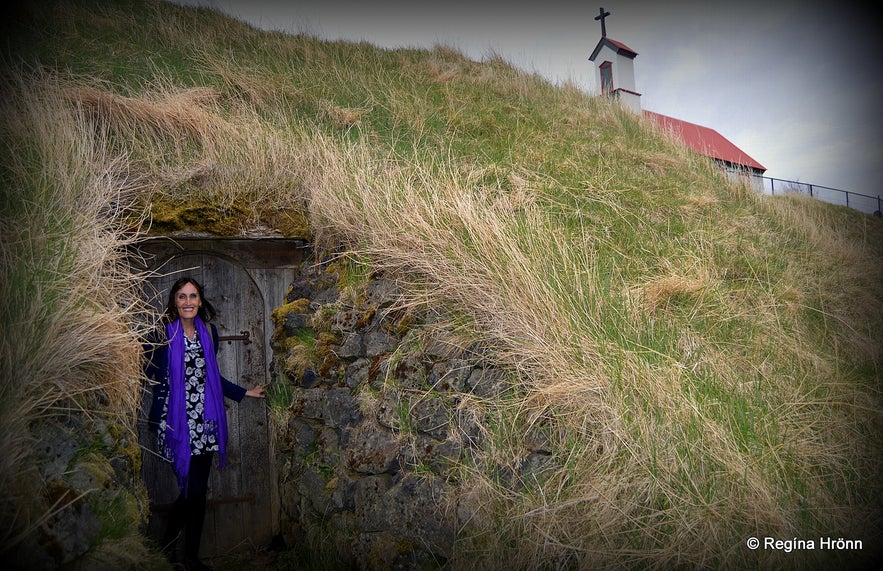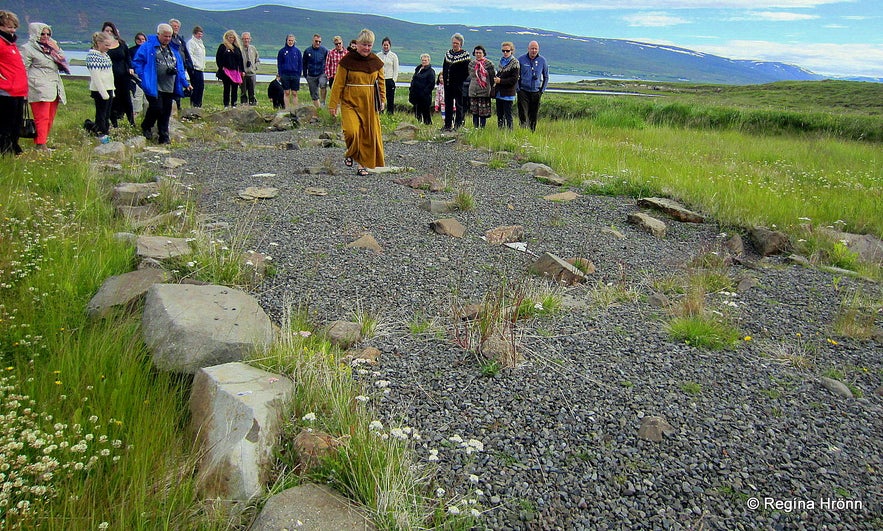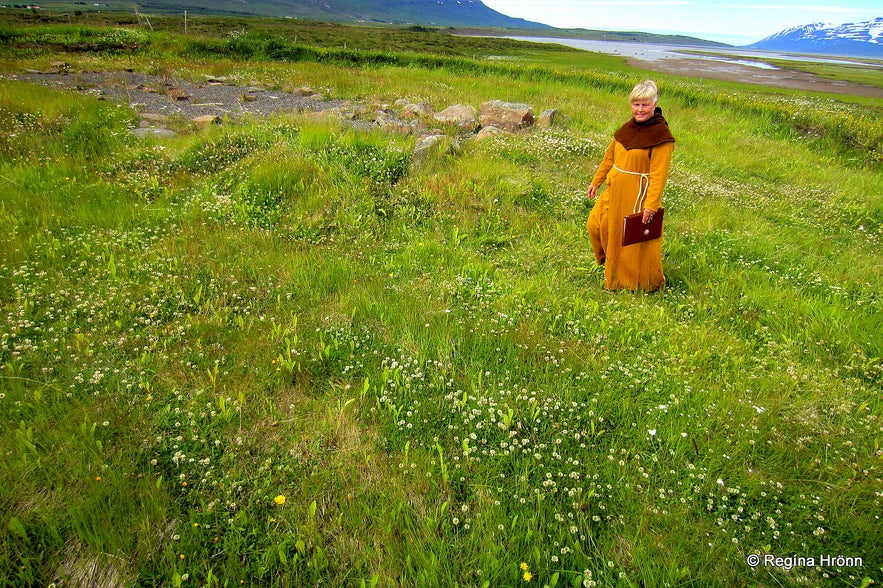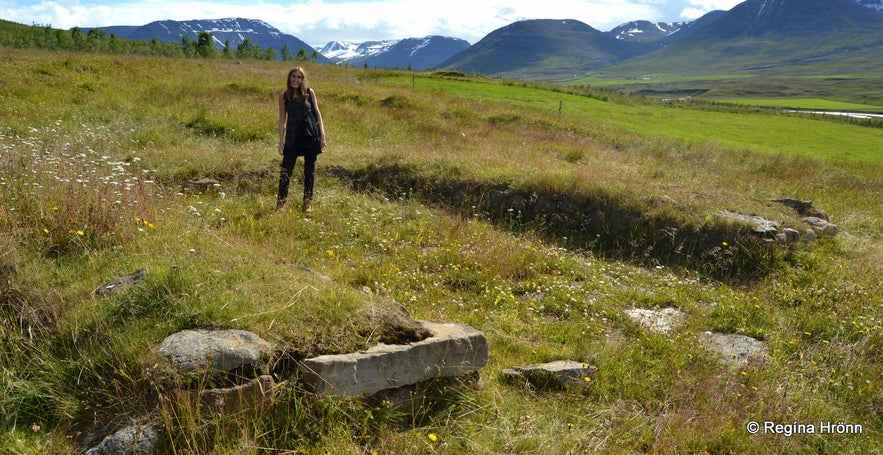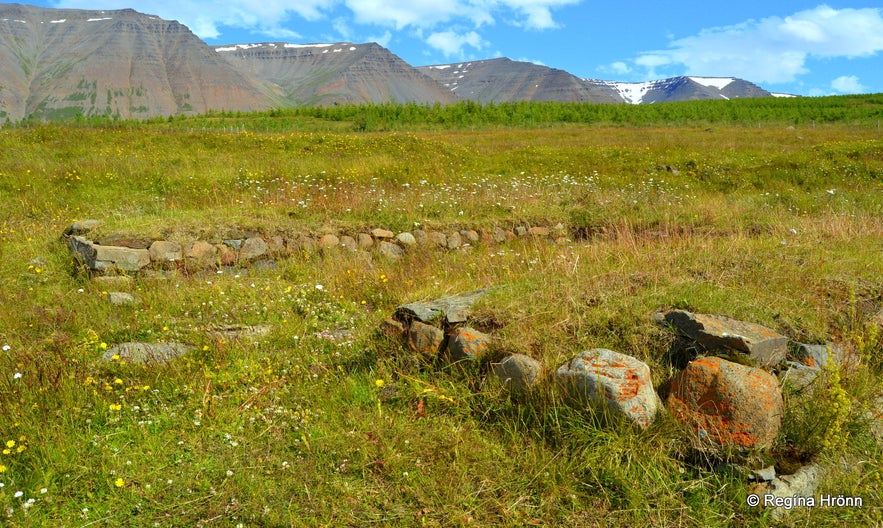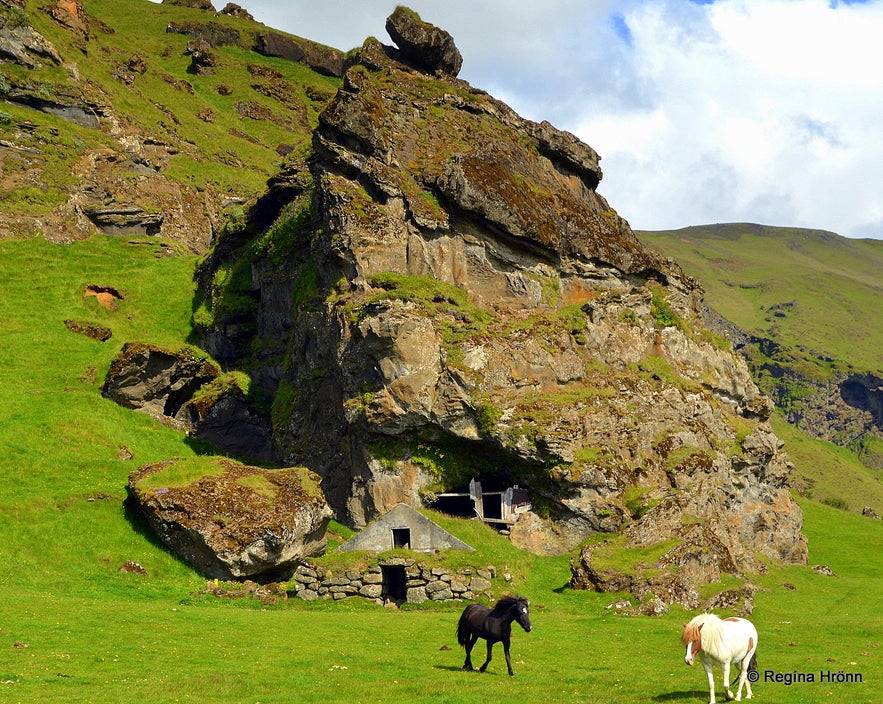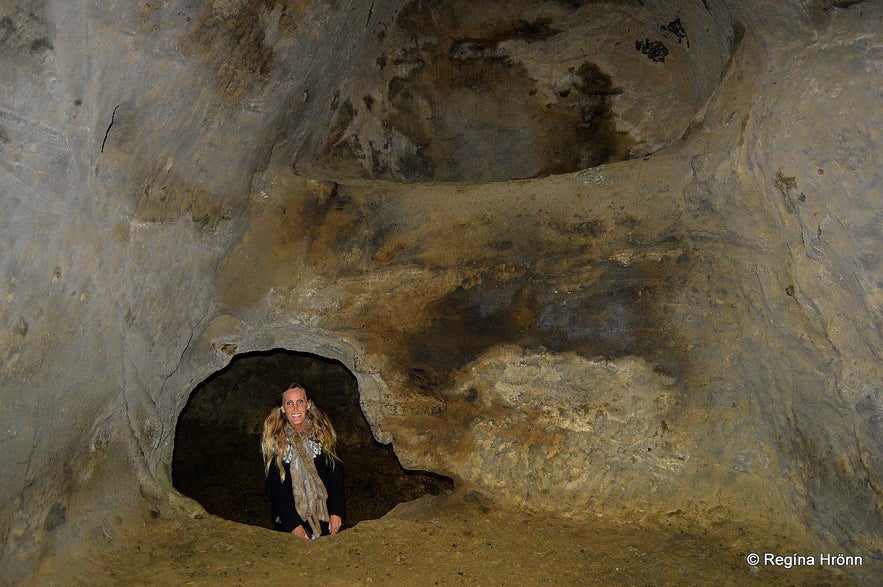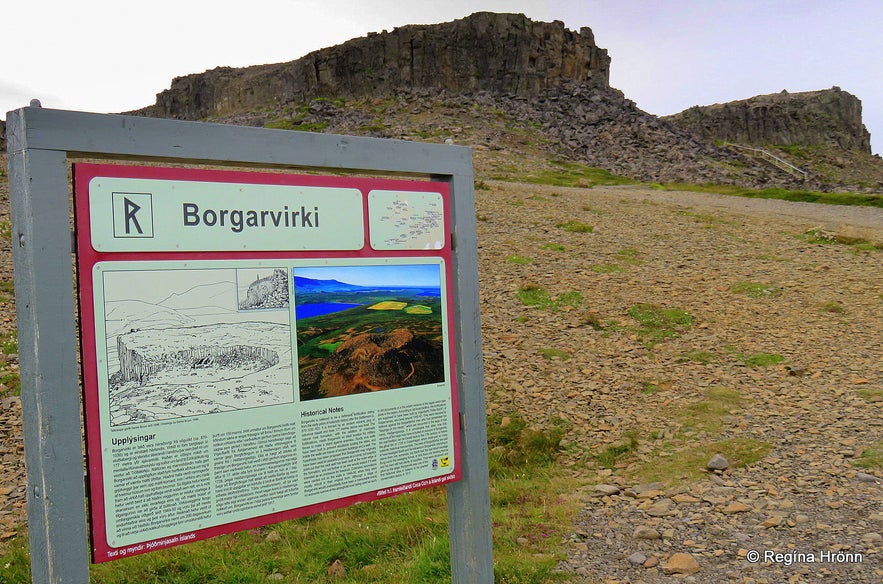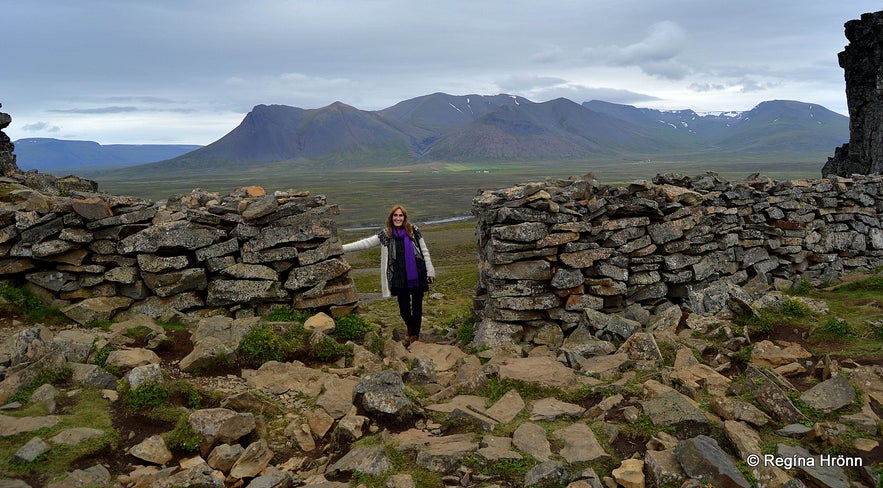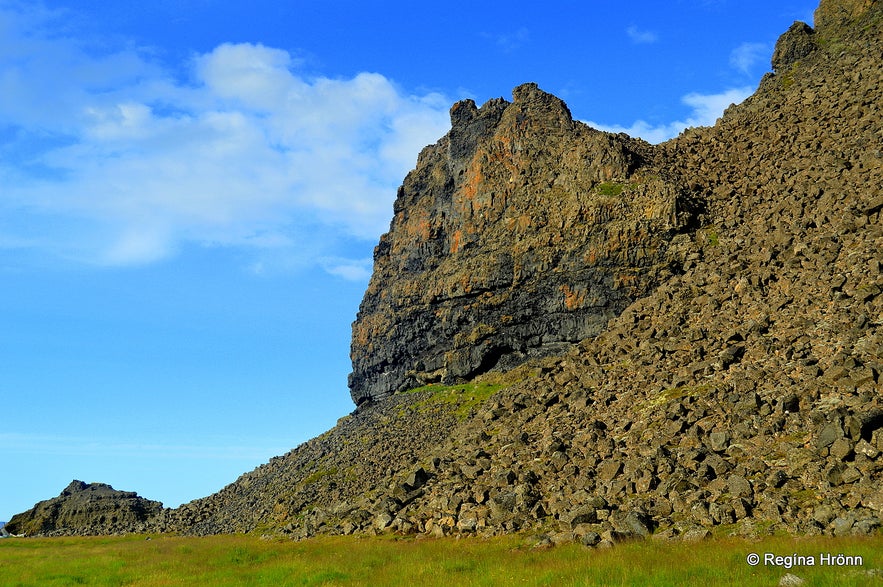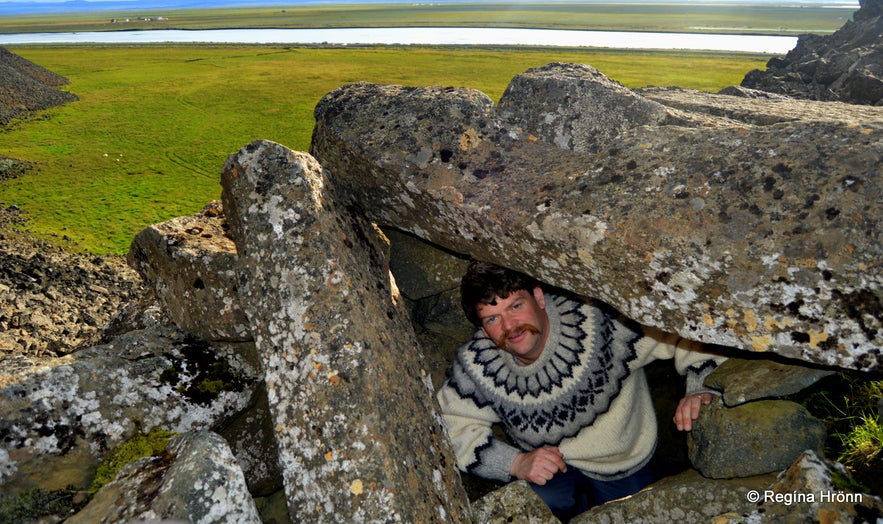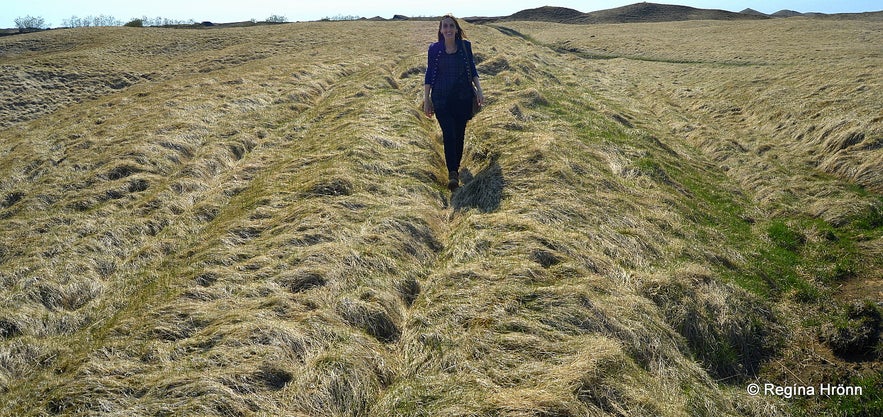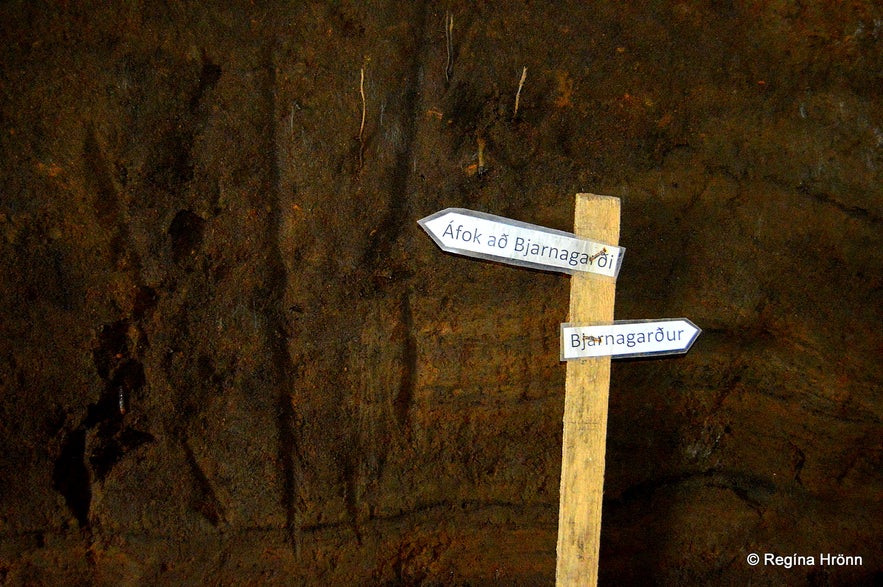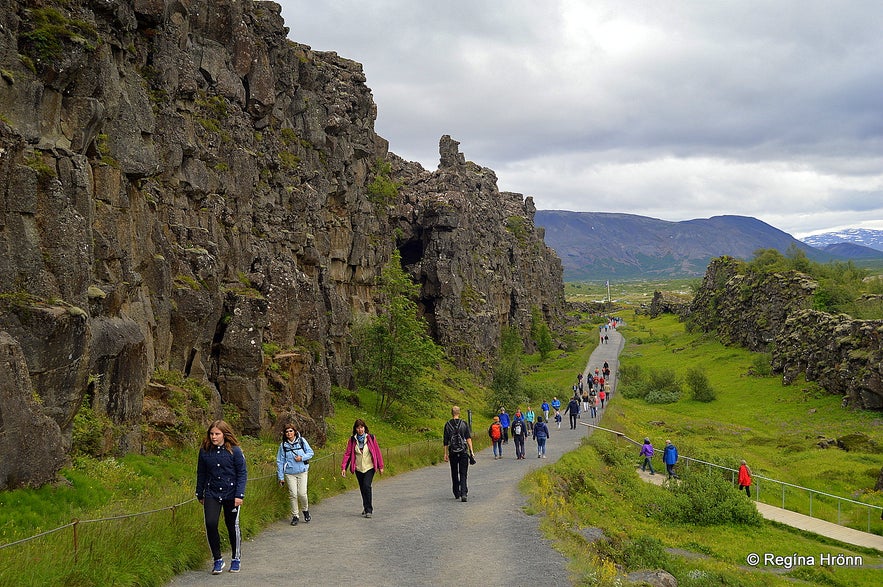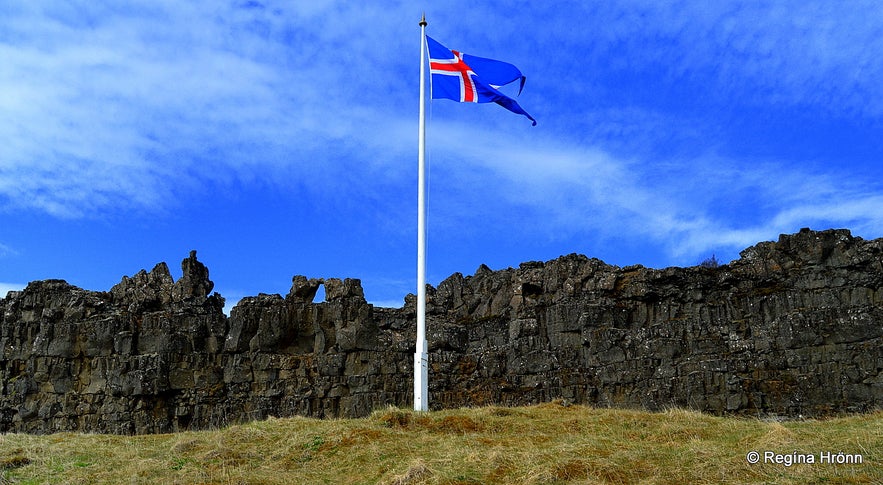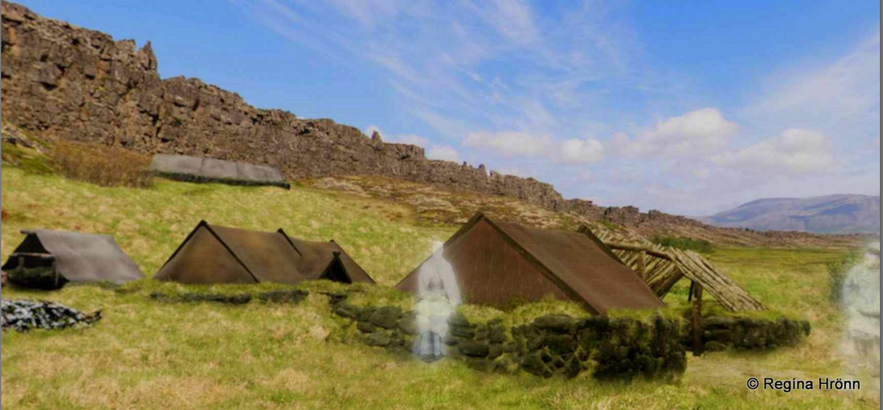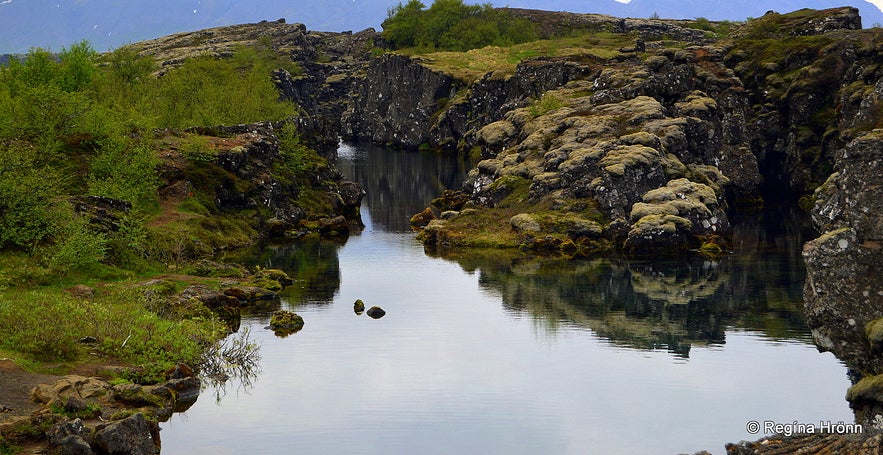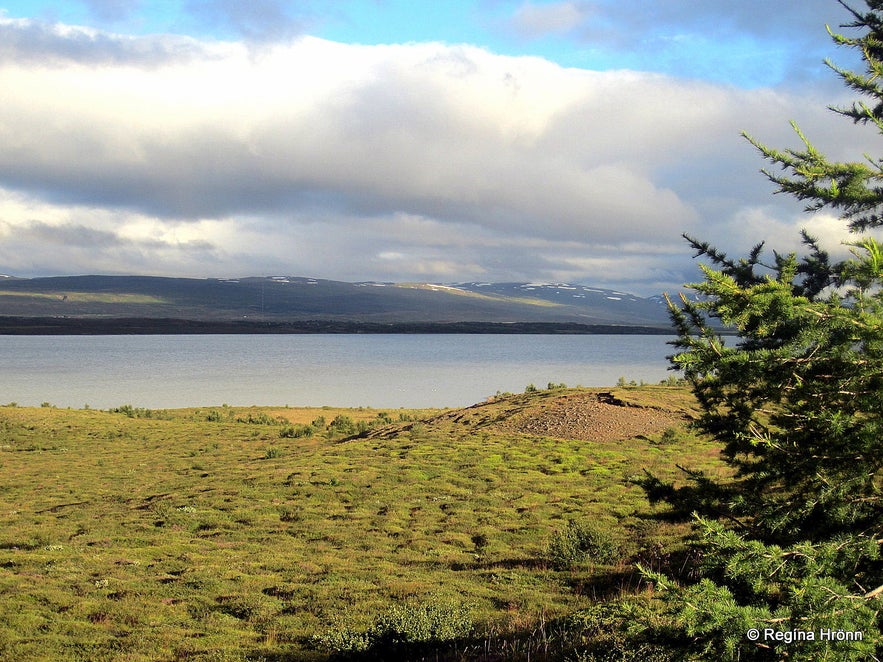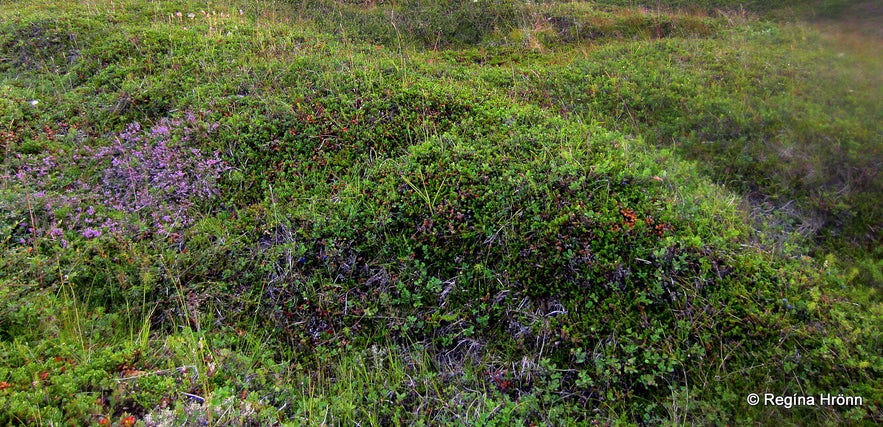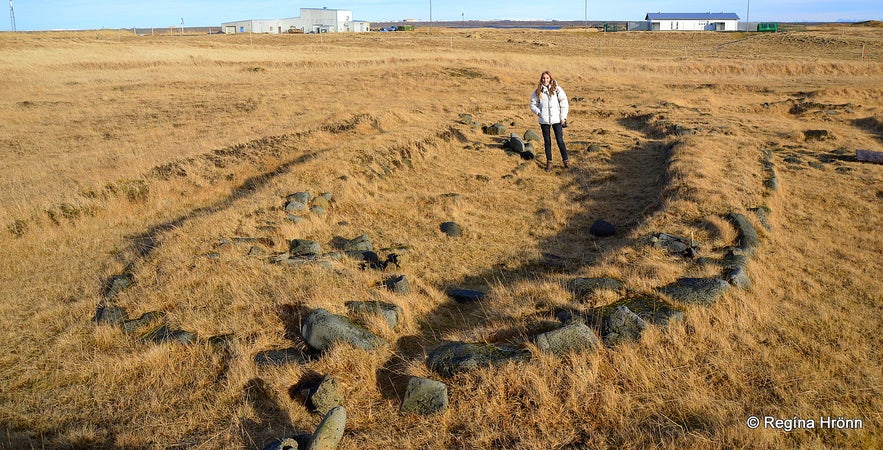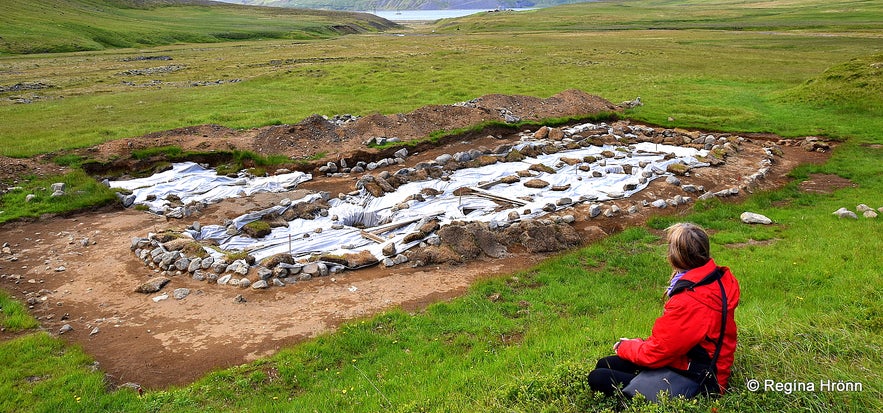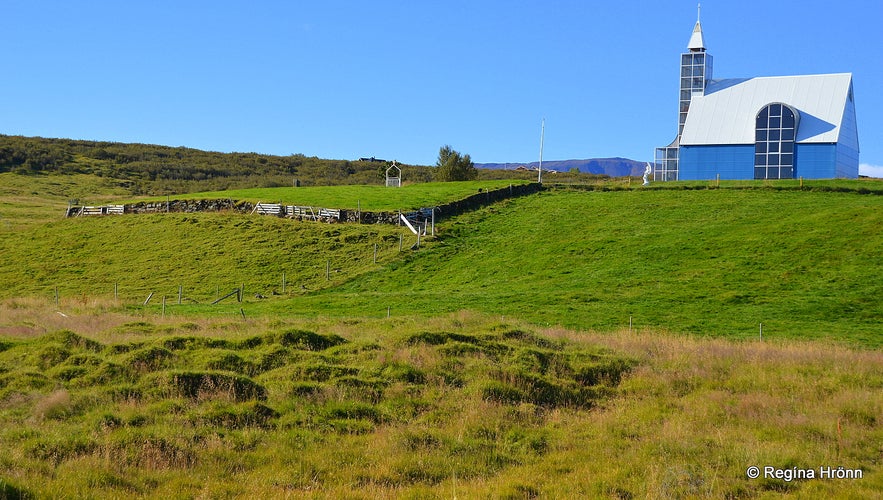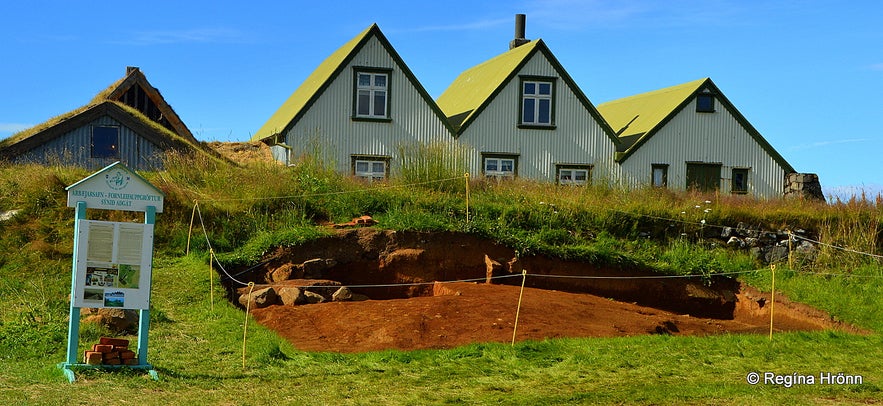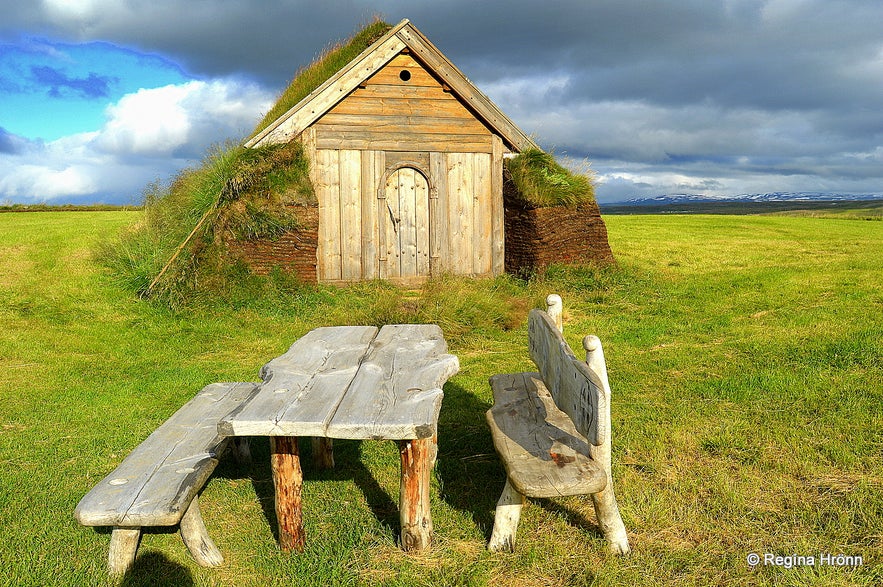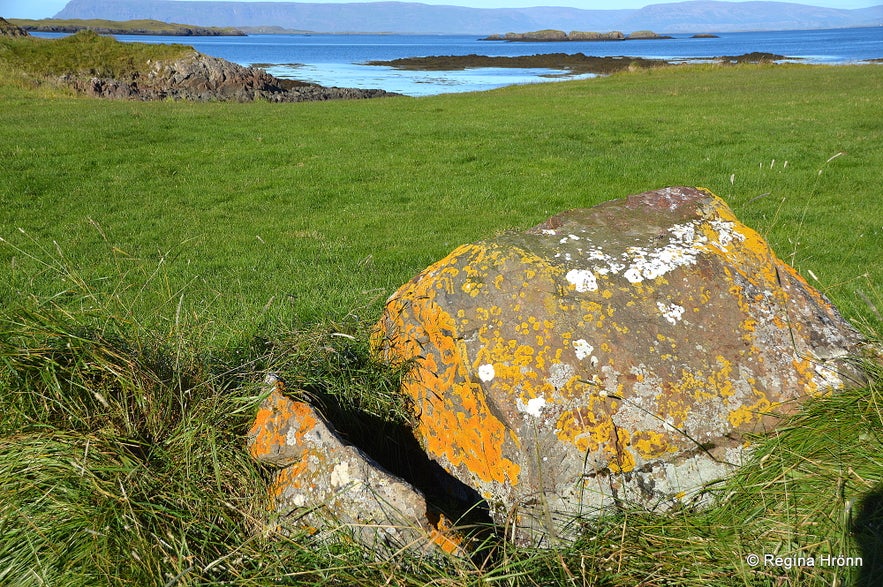In this travel-blog, I want to show you the Viking ruins - the archaeological sites where settlement-age farms have been discovered in Iceland. I have visited several such archaeological sites during my many years of travels in my country.
I am often asked about Viking ruins and have written this travel-blog as a reference to show to those who are interested in the Vikings and Viking ruins. Most of our Viking stuff is still hidden in the ground, but we have discovered many ruins and pagan graves around Iceland.
I must reiterate though that this is a travel-blog and by no means a professional article ;)
Opening photo: Eiríksstaðir in West Iceland
Flókatóftir - the ruins of Hrafna-Flóki
Flókatóftir
On the southern part of the Westfjord region of Iceland, in Vatnsfjörður fjord at Barðaströnd, 13 ruins from 2 periods have been found.
We would like to believe that the 6 older ruins are the ruins of Hrafna-Flóki.
The Norwegian Hrafna-Flóki Vilgerðarson arrived in 865 in Iceland before it was settled by the Vikings.
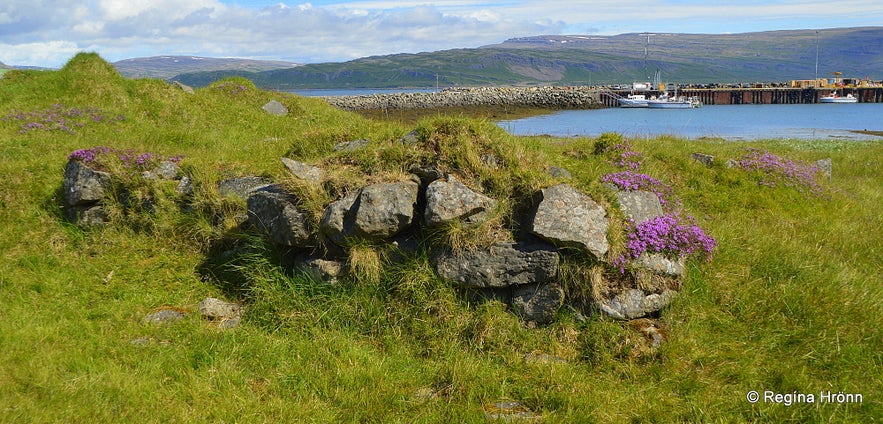 Ruins at Flókatóftir
Ruins at Flókatóftir
The second chapter of the Hauksbók version of Landnámabók - the Book of Settlement, tells us about Hrafna-Flóki, who is believed to have stayed in Iceland for a year.
Not knowing about the harsh, long winters of Iceland Hrafna-Flóki and his men did not know that they had to collect hay as fodder for the livestock, which they had brought with them.
The livestock, not having much to eat, died as a result.
Hrafna-Flóki thus left Iceland - but before he left, he gave Iceland its name. He climbed up on a mountain close by and looked north - what he saw was a bay filled with drift ice. So this is how Iceland got its name.

Flókatóftir ruins
The walls of the longhouse (the oldest type of Icelandic turf house), the boathouse, and a fire pit, which Hauksbók describes, have been found here. Then there are younger ruins from 1900-1930.
Flókatóftir ruins were listed as an archaeological site back in 1930.
Flókatóftir is located by Brjánslækur in Barðaströnd in the Westfjords of Iceland. The ferry Baldur stops at Brjánslækur, and it is easy to spot the ruins.
The Settlement Exhibition Reykjavík 871±2
The Viking longhouse
You don't have to go far to see Viking ruins, as we have some in Reykjavík city - and Garðabær town, which belongs to the Great Reykjavík area. Let me first show you the Viking ruins in Reykjavík.
In Aðalstræti, the oldest street in the capital city of Iceland remains of a Viking longhouse were unearthed back in 2001. It is believed that this longhouse dates back to around 870. This might even be the longhouse of the first settler of Iceland, Ingólfur Arnarson, who settled Reykjavík. Thus these ruins might be the oldest remains in Reykjavík.
The ruins are located in the south-end corner of Aðalstræti - Main Street. They were discovered during construction work when a hotel was being built on this spot. The construction work had to be stopped while archaeologists examined the remains.
Here in the oldest part of Reykjavík, it is common to find Viking remains while digging for the foundation of a new building. So all construction work screeches to a halt, while the remains are being examined. The solution for the longhouse in Aðalstræti was to build a museum around the remains and the hotel on top if of the museum.
When you visit this museum, you will see the open excavations of the longhouse in the middle of the museum. The museum uses interactive technology, and all around the longhouse lit-up images have been added to give visitors an idea of what the view from the longhouse must have been like.
Thus you get an idea of what Reykjavík and its surroundings must have looked like back then.
At the museum, you will also see Viking artifacts on display, which were unearthed on the site. What I found to be of interest was a small glass fragment, which is the oldest fragment of a Viking Age drinking vessel found in Iceland! A silver bracelet from the oldest layers of human habitation also caught my attention. It is decorative, stamped with triangles with three dots each.
The name of the museum refers to the year that Ingólfur Arnarson, the first settler, is believed to have arrived in Iceland - Settlement Exhibition 871 +/-2 means to give or take a couple of years.
Check them out at Settlement Exhibition 871 +/-2 which is part of the five Reykjavik City Museums. Also, check out the Reykjavík City Card if you want to visit this museum and other interesting museums in Reykjavík. The Reykjavík City Card gives you access to many museums and galleries, including the Settlement Exhibition.
Hofsstaðir - Ruins of a Viking Settlement Age Farm in Garðabær
Hofsstaðir ruins
In Garðabær town, which is a part of the Great Reykjavík Area, a Viking Settlement Age farm was discovered back in 1986.
This large Viking longhouse dates back to around 870-930 and is 8 x 30 meters on the outside, but the inside floor surface is 170 sq.m.!
It is believed that on such a big farm a wealthy farmer must have lived together with some 20-30 people. We don't know who they were, but it seems to have been inhabited until the 12th century. The owner of this land was Ingólfur Arnarson, Reykjavík's first settler.
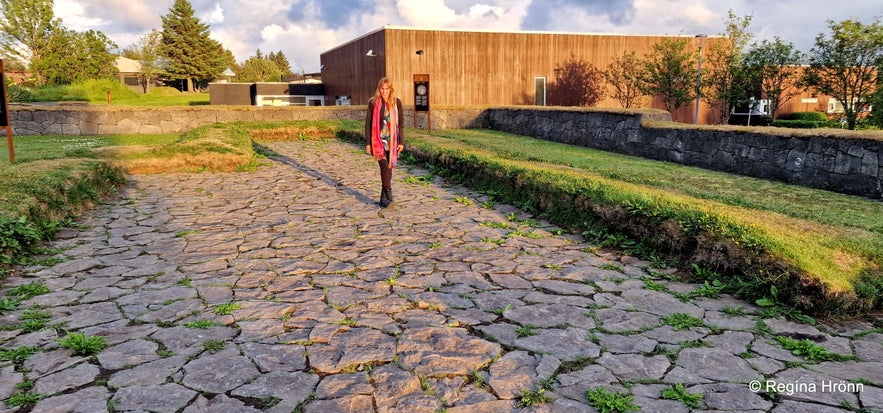
Hofsstaðir Viking longhouse
Around 300 items have been unearthed here, together with an unusual bronze broach, pins, knives, instruments, and lots of loom weights and spindle whorls were unearthed in a weaving room.
You can visit this longhouse free of charge and have a further look at it.
Check out my travel-blog about Hofsstaðir with a lot more photos and information on how to find it.
Stöng - Ruins of a Real Viking Settlement Manor 
Stöng Viking longhouse
In Þjórsárdalur valley upcountry in South Iceland, you will find ruins of a real Viking Settlement-Age farm - Stöng. The Vikings settled here not knowing about the proximity of this area to the notorious Hekla - the Queen of Icelandic volcanoes.
Mt. Hekla erupted in 1104 for the first time after the Vikings settled in Iceland. This eruption caused havoc in the Þjórsárdalur valley of some 22 settlement farms.
Eight of these farms were excavated, but only the exceptionally well-preserved ruins of Stöng settlement farm remain above ground - the others were covered again. Additional factors might have contributed to the inhabitants leaving, cold weather f.ex.
Archaeologists excavated the ruins of Stöng back in 1939, but this settlement farm was hidden under layers of tephra.
What you can see at Stöng are the stone foundations of the settlement-age farm - a Viking longhouse. They have been covered with a red roof and a protective shelter.
You can visit the settlement-age ruins of Stöng in the summertime, but better still - visit the more accessible Þjóðveldisbærinn Saga-age farm, which is a hypothetical Viking farmhouse, a hypothesis house of the Stöng ruins.
The Saga-age farm was erected in 1974 when Icelanders celebrated the 1100-year-anniversary of the Icelandic settlement.
I have written another travel-blog about Stöng - Ruins of a Real Viking Settlement Manor and the Reconstructed Saga-Age Farm in Iceland with a lot more photos and information.
Þjóðveldisbærinn - the reconstructed Viking longhouse
To visit this area you can rent a car in Reykjavík and make a day trip of it, as it is located only 122 km away from Reykjavík.
A bumpy gravel road will take you to Stöng in the summertime, so a 4x4 is needed. If you will only be visiting the hypothetical Saga-Age farm 2WD is sufficient as the road is paved all the way. Let's always show such Viking ruins utter respect and leave nothing behind.
Eiríksstaðir - the ruins of a Viking longhouse
The Viking ruins at Eiríksstaðir
At Eiríksstaðir in West Iceland, you will find the ruins of a Viking longhouse from the 10th century. Here the Vikings Eiríkur rauði - Erik the Red and Þjóðhildur lived. And at Eiríksstaðir their son Leifur heppni - Leif the Lucky (approx. 980-1020) was born. Leif is famous for reputably being the first European to discover America.
At Eiríksstaðir a hypothesis Viking longhouse has been erected. Here you can see how the Vikings lived and worked and listen to stories by the long-fire. The hypothesis house was opened in the year 2000, and at the same time, a replica of the Viking ship Íslendingur sailed to America in the trails of Leif the Lucky - some 1000 years earlier.
This statue of Leif the Lucky has been erected close to the ruins
The original ruins are to be found a short distance (some 50-100 meters) above the replica. Here you can see the outlines of the more than 1000-year-old longhouse.
An archaeological excavation took place at Eiríksstaðir from 1997-1999, and a small Viking longhouse was discovered, made of turf and rock as was the norm back then.
The old longhouse seems to have been hit by a mudslide and repaired. The last inhabitants most likely moved out by the end of the 10th century.

Eiríksstaðir hypothesis Viking longhouse in 2019
Do visit them and experience the Viking era firsthand, so to speak - you can find their website here Eiríksstaðir.
I have written another travel-blog on Viking Areas in Iceland - Eiríksstaðir Long House in West Iceland, with photos from the inside of Eiríksstaðir, the guided tour, and information on how to reach it. This was my second travel-blog on Guide to Iceland back in 2013 :)
Vatnsfjörður in the Westfjords of Iceland - the Ruins of a Viking Estate
The information sign by the Viking ruins in Vatnsfjörður
In Vatnsfjörður on the northern side of the Westfjords of Iceland, extensive Viking ruins have been found. This land was settled by the Viking Snæbjörn, the son of Eyvindur austmaður.
Ruins of a Viking longhouse were discovered here during archaeological excavations from 2003-2013, along with a smithy and several other smaller houses.
Standing inside the Viking longhouse at the ruins in Vatnsfjörður
I have written another travel-blog about my visit: Vatnsfjörður in the Westfjords of Iceland - the Viking Estate and Grettisvarða Cairn
Grettisvarða cairn
In the historic Vatnsfjörður in the Westfjords of Iceland - above the Viking ruins - you will find a huge cairn called Grettisvarða cairn.
It is believed that the Viking outlaw, Grettir Ásmundarsonar, a.k.a Grettir, the Strong, built this cairn.
Another idea is that it could have been a watchtower.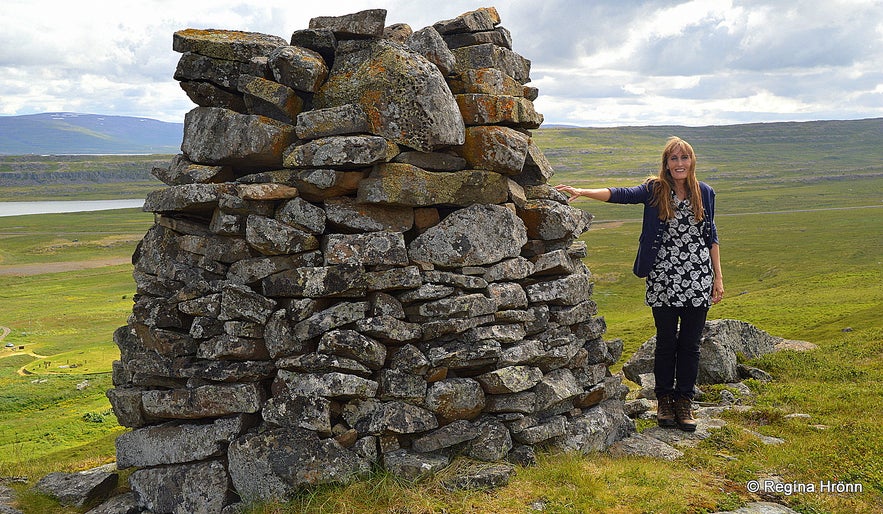
Grettir stayed in Vatnsfjörður for some time during his outlawry (which lasted for almost 20 years). Grettir, the hero of the Saga of Grettir, was saved from hanging by the lady of the estate, Þorbjörg hin digra - Þorbjörg the portly, when he had robbed the neighbouring area.
You can find much more information in my travel-blog: Vatnsfjörður in the Westfjords of Iceland - the Viking Estate and Grettisvarða Cairn.
Reykholt - ruins of Chieftain Snorri Sturluson's manor
Snorralaug at Reykholt - protected ruins
Reykholt is one of the historic sites in Iceland, the stately home of the Chieftain and historian Snorri Sturluson (1179-1241) of the powerful Clan of Sturlungar. Reykholt was a cultural and ecclesiastical centre, and here one of the first listed archaeological remains in Iceland is to be found - Snorralaug - Snorri's geothermal pool.
This reconstructed pool, which was first mentioned in the Book of Settlements as being in use in the 10th century, is amongst Iceland's best-known heritage sites. And as such, there is strictly no bathing in it.
Next to the pool is the covered underground passage of Snorri Sturluson, which seems to have led from the pool and into the manor of Snorri. The underground passage was discovered back in 1931 and the first part of it has been reconstructed.
The underground passage at Reykholt - protected ruins
During archaeological excavations, some medieval buildings have been found - the large fortress of Snorri Sturluson. Even the stairs where Snorri was killed by his enemies have been unearthed. Unfortunately, Reykholt has not received enough funding to continue the excavations, and the ruins have been covered with turf.
But Snorri's grave can be visited by the old church - or at least we believe that he was buried in this grave. And in the cellar of the new church, you can visit Snorrastofa - an exhibition on Snorri Sturluson and see photos and information about Snorri and the archaeological excavations. At the exhibition, you can also see artifacts found during the excavations.
Archaeological ruins at Reykholt
You can read much more in my travel-blog the historic Reykholt in West Iceland & Snorri Sturluson - the most influential Icelander, but I stayed at Reykholt for 2 days to learn more about Reykholt and Snorri Sturluson.
A lecture at the National Museum about Reykholt: Reykholt. The Church Excavations. Guðrún Sveinbjarnardóttir (in Icelandic).
To reach this area, you can rent a car in Reykjavík and drive to Reykholt which is only 108 km away in West Iceland.
Vopnafjörður - ruins of a Viking farm
The Viking sword and half a shield
In Vopnafjörður in East Iceland, a longhouse from the Viking age was discovered. These ruins, which were found during a dig back in 2006 are adjacent to the current church at Hof.
A monument has been erected on the site of the ruins - a big Viking sword and half a shield. It is called Varða Vopnfirðingasögu - the Cairn of the Saga of Vopnfirðingar, erected in 2013. Excerpts from the Saga have been engraved on the shield.
The story of the people living in this area from the 9th century until the beginning of the 11th century is told in one of the Icelandic Sagas - the Saga of Vopnfirðingar.
As in other places in Iceland back then, there were power struggles between the most powerful clans - here the Clans of Hof and Krossavík ruled - two Chieftains, Brodd-Helgi at Hof and Geitir Lýtingsson and their sons. These men were best friends who turned into enemies and their sons were first cousins.
Hofskirkja church
I gather that the ruins have been recovered with turf, as is often the case, to protect them, as I didn't see them.
To reach this area you can drive up to the East Fjords in a couple of days. In the vicinity, you will find one of the main turf-houses in Iceland - the red-painted Bustarfell.
The Viking ruins in Herjólfsdalur in the Westman islands
The hypothetical Viking longhouse in Herjólfsdalur
In Herjólfsdalur valley in the Westman Islands in South Iceland, the Viking ruins of what we believe to be Herjólfsbærinn - Herjólfur's old farmstead were discovered.
It was back in 1924 when the first director of the National Museum of Iceland was doing excavation work in Herjólfsdalur valley that he discovered 3 ruins; one Viking longhouse along with two smaller houses.
Herjólfsdalur - a hypothetical Viking house
From 1971-1981 extensive archaeological digging took place in Herjólfsdalur valley - a little bit delayed by the volcanic eruption in 1973.
The ruins of 8 turf houses were discovered from around 4-5 building periods.
These ruins might have been the farmstead of Herjólfur Bárðarson, the first settler of the Westman Islands in around 900. Some of them might even be older.
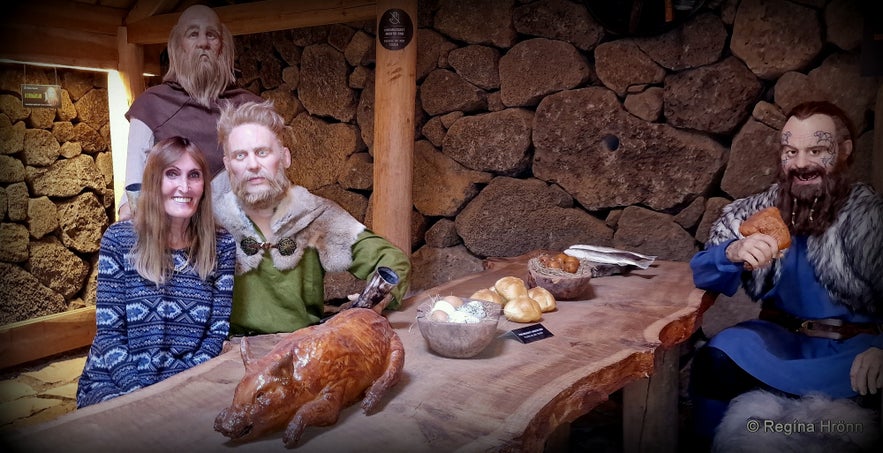 The Viking exhibition in Herjólfsbær
The Viking exhibition in Herjólfsbær
A hypothetical replica of the 10th-century farmstead was erected in 2006 in Herjólfsdalur valley - a longhouse and an outhouse built with turf, wood, and rock - it blends in perfectly with the landscape.
Read more in my travel-blog Herjólfsbærinn - Herjólfur's old farmstead in the Westman Islands.
Hofstaðir at Mývatn - ruins of a Viking age longhouse and a pagan temple
The Viking longhouse at Hofstaðir in Laxárdalur valley
A large Viking longhouse, dating back to around 940 and in use until 1030, has been discovered at Hofstaðir at Mývatn in North Iceland. The longhouse at Hofstaðir is one of the largest of its kind yet to have been unearthed in Iceland
The banquet hall was first built in around 940 and was around 28 meters but enlarged to 38 meters later on. At around 1030 the hall was deconsecrated.
It seems that the pagan banquet hall and a church coexisted at Hofstaðir after the conversion to Christianity back in the year 1000.
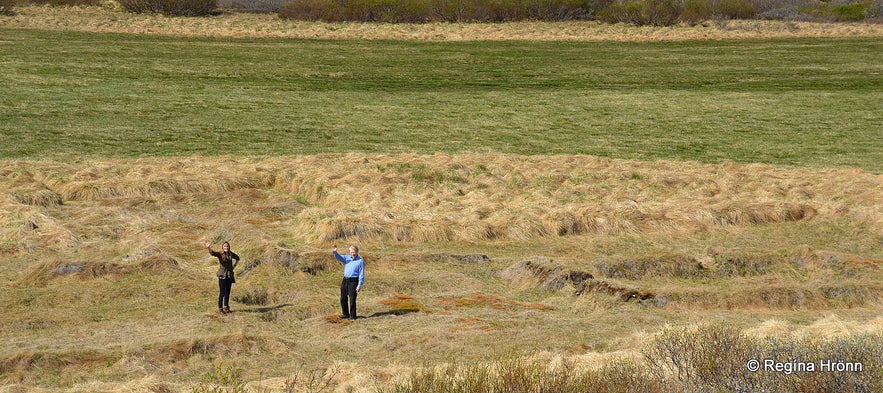
Hofstaðir in Laxárdalur valley - the Viking longhouse - visiting with my father-in-law
The last occupants at Hofstaðir, two brothers, died in 2015 and Hofstaðir now belongs to the Icelandic state.
At Hofstaðir ruins of 2 churches have been found. Various artifacts have been discovered at Hofstaðir; knives, loom weights and spindle whorls (a very common discovery at such sites), silver, combs, various animal bones, etc.
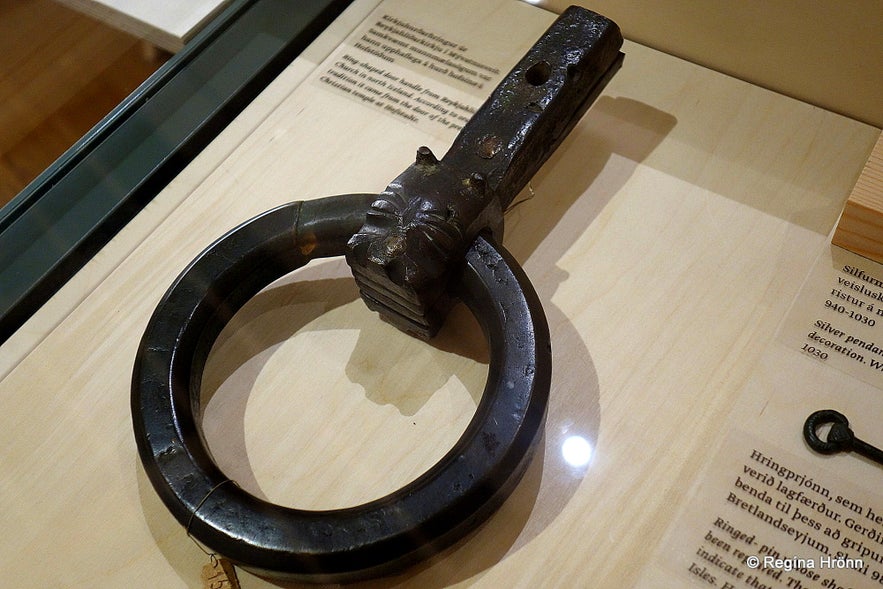
A church ring from Reykjahlíðarkirkja church - folklore tells us that this is the ring from the temple at Hofstaðir
There are also speculations about Hofstaðir having been a pagan temple as so many cattle skulls have been found here. The temple would have been located in an extension on the northern side of the banquet hall.
Some of these artifacts were on a special display at the National Museum in 2020-2021. Like the church ring from Reykjahlíðarkirkja church in Mývatn in North Iceland in my photo above. According to oral tradition, this ring (door handle) was from the door of the pagan temple at Hofstaðir.
A silver pendant was found in the floor of the banquet hall - see my photo below. A guest might have dropped it and it became lost in the dirt floor. There is some incised decoration in the pendant, but I cannot see it.
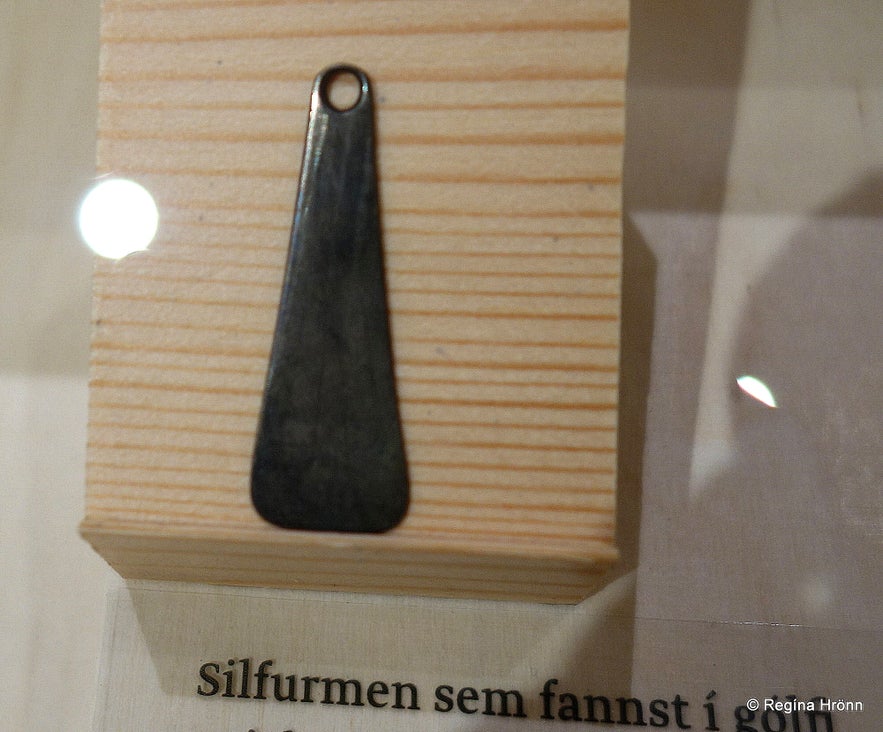
A silver pendant found in the floor of the banquet hall
I have visited the ruins as my husband's family owns a summer cottage opposite Hofstaðir, across the Laxá river, but I believe that they are not accessible to the public as they are still under archaeological examination.
I am especially interested in this archaeological site and have attended a couple of lectures held at the National Museum about Hofstaðir.
Saga úr jörðu Hofstaðir í Mývatnssveit - Hildur Gestsdóttir og Hrönn Konráðsdóttir in Icelandic
Árdagar íslenskrar fornleifafræði. Rannsóknir á Hofstöðum í Mývatnssveit in Icelandic
Hofstaðir. Rannsóknir 1992 - 2020 - in English
Ruins at Hofstaðir in Laxárdalur valley
I often sit on the porch of the summer cottage thinking about what this quiet valley must have looked like when the Vikings resided here. Some ruins have been found very close to the summer cottage and we think that a wall from this area is right next to the cottage.
You can read more about Hofstaðir here - it is wrongly marked on the Iceland map though.
See also (in Icelandic only): Merkur fornleifafundir í Mývatnssveit
Skálholt Episcopal See
At Skálholt in South Iceland, the first Episcopal see in Iceland was founded back in 1056.
It is one of the best-known historic places in Iceland and one of Iceland's most important cultural and political centers from the mid-11th century until the 18th century. In the 12th century, a timber cathedral was erected at Skálholt.
At the small museum in the crypt, you will see the most important find at Skálholt - the stone sarcophagus of Bishop Páll Jónsson, who died in 1211. It was unearthed in August 1954, during excavations for the foundations of the new church.
The stone coffin in the crypt at Skálholt
A crosier (bagall) was found with the bones of Páll in the sarcophagus.
The crosier is made of a walrus tusk and it is believed to have been made around 1200 in Iceland.
The crosier is on display at Þjóðminjasafnið - the National Museum of Iceland. It is behind glass so it is very difficult to photograph and below is my best shot of it.
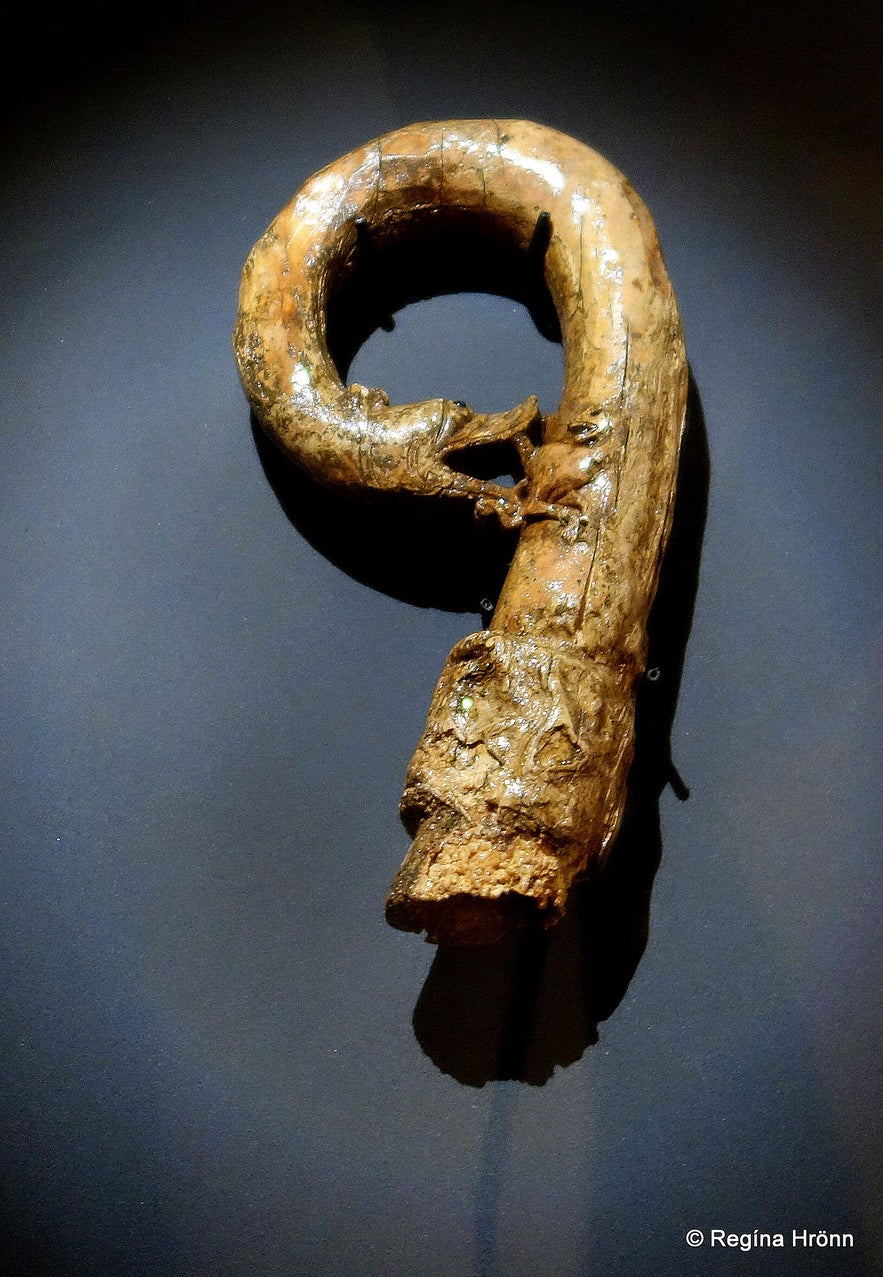
The crosier most likely dates back to around 1200
A 13th-century tunnel leads to the crypt. This tunnel is mentioned in Sturlunga - the Saga of the Sturlungs, when Órækja Snorrason, the son of the great Chieftain Snorri Sturluson, attacked Gissur Þorvaldsson, in January 1242 at Skálholt.
Gissur the Chieftain of the Clan of Haukdælingar was influential in having his former father-in-law, Snorri Sturluson, killed on September 23rd, 1241 - Órækja wanted revenge.
Remember the bloody Viking battles in Skagafjörður and the battles between these most powerful Viking clans in Iceland? Órækja was married to Arnbjörg, the sister of Kolbeinn ungi, the Chieftain of the Clan of Ásbirningar. So everybody seems to have been connected in the Age of the Sturlungs, either by blood or by marriage.
Skálholt - the medieval tunnel
The tunnel was rebuilt in 1958. I was seven years old when I first walked through this tunnel and back then I was terrified walking through a medieval tunnel leading to a medieval stone coffin ;)
Next to the cathedral, you will find archaeological ruins of the Bishop's residence, which have been excavated and marked with information signs. They are not Viking ruins, so I don't include them in this travel-blog.
You can include a visit to Skálholt in your Golden Circle tour. You can either join a tour which includes Skálholt or drive there yourself. Here is the Skálholt website and here is my travel-blog about Skálholt: The Historic Skálholt Episcopal See in South Iceland.
The historic Keldur
Keldur turfhouse and Keldnakirkja church
At Keldur in South Iceland, you will find one of the oldest remaining structures in my country. It is an underpass, which is believed to date back to the 12th - 13th century from the time of the Age of the Sturlungs.
The underpass, which was found by chance during diggings for a septic tank, and researched by archaeologists in 1998, leads from the farm and down to the creek.
It might have been an escape underpass or a place to hold down the fort, during the turbulent Age of the Sturlungs. The underpass is 25-metres long.
The medieval underpass at Keldur
Old ruins of 16-18 farmsteads have also been found at Keldur.
My travel-blog Keldur turf house - is this the oldest house in Iceland? Find out more at the website of our National Museum Keldur at Rangárvellir.
Gásir - medieval trading place
Examining the ruins of the medieval church at Gásir
The main trading post in Northern Iceland from the 11th century - the 15th century is to be found at Gásir in Eyjafjörður fjord. At Gásir many antiquities have been discovered.
Ruins of a medieval church have been found at Gásir - a large church from the 14th century.
Not much is known about this church - but we know that back in 1359 it got damaged in a storm. This medieval church is the second largest church to be found in Iceland, some 16 x 5 meters, with a 7-8 meters tall church tower.
A guided tour of the Gásir ruins
Many ruins of sunken booths have been discovered at Gásir and many things related to trading. It is believed that sulfur was prepared here for export.
Gásir is mentioned many times in Sturlunga - the Saga of the Sturlungs.
Experimental research was performed in 1907 and 1986 at Gásir, together with archaeological research from 2001-2006 by the Museum of Akureyri (Minjasafn Akureyrar), the National Museum of Iceland, and the Icelandic Institute of Archaeology.
 When I attended the medieval days at Gásir I got a guided tour of the ruins of the church - that is why my guide was dressed in medieval clothes.
When I attended the medieval days at Gásir I got a guided tour of the ruins of the church - that is why my guide was dressed in medieval clothes.
Gásir is under the care of the Icelandic Archaeological Preservation and is preserved.
For more information check out my travel-blog on Gásir and the Medieval Days.
The church ruins from early Christianity at Neðri-Ás
By the ruins of the old church at Neðri-Ás in Hjaltadalur valley
Ruins of one of the churches from early Christianity in Iceland were discovered at Neðri-Ás in Hjaltadalur valley in North Iceland. This church might even have been the first church erected in Iceland!
In the 10th century, the Viking Þorvarður Spak Böðvarsson lived at Ás. He built a church on his farm in 984 - some 16 years before Christianity was adopted in Iceland.
He is believed to have adopted Christianity from the missionary Þorvaldur víðförli, who was a missionary in Iceland in the year 981.
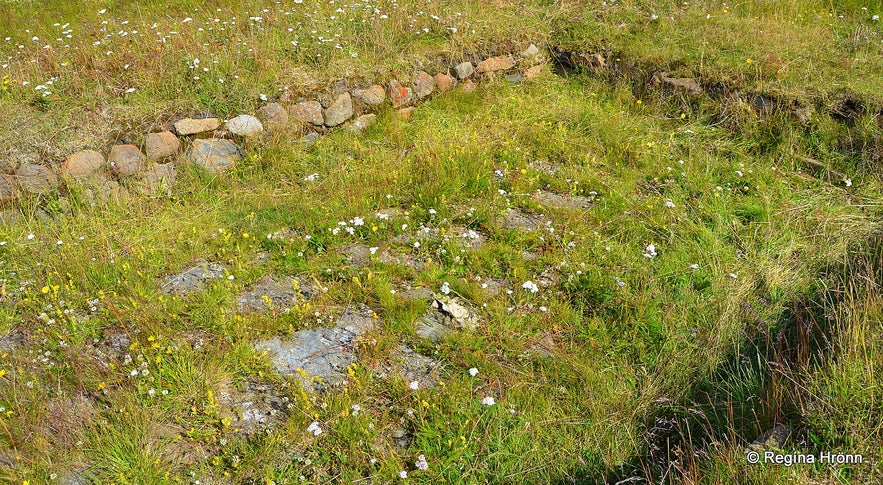
Archaeological digs took place at Neðri-Ás from 1998-1999, and these church ruins were unearthed. The church ruins were discovered under the ruins of a smithy, which was beneath the ruins of another structure, which was beneath a sheep barn from the last millennium.
The sheep barn had been referred to as bænhúsið - the house of prayer. Isn't this amazing?
Ruins of a couple of other medieval churches were also found. The ruins show that these ancient churches were small, only some 12 m2.
The ruins of the old church at Neðri-Ás in Hjaltadalur valley
Þorvarður imported wood for the church from England. Around 100 graves were found by the church - the bones most likely date back to before 1104. Hólar episcopal see in the vicinity was founded in 1106, so the churchyard at Hólar was most likely used from that time instead of the churchyard at Neðri-Ás.
The church ruins are right behind Neðri-Ás farm. When I was exploring the ruins I heard a loud "muuuuu" and saw a flock of cows coming running toward me.
I was a bit scared as I think cows are so big and don't like big animals running toward me, let alone a whole flock of them, but cows are very curious, so they were just checking me out ;)
The monument in Hjaltadalur
A monument has been erected by the road leading to Neðri-Ás. On it is written: "Þorvarður Spak Böðvarsson lét gera kirkju á bæ sínum í Ási. En kirkja sú var ger sextán vetrum áður kristni var í lög tekin á Íslandi. - Kristnisaga".
I can translate it to English for you if you want ;) "Þorvarður Spak Böðvarsson had a church erected on his farm at Ás. But that church was erected 16 winters before Christianity was adopted in Iceland. - the Saga of Christianity".
The farmers at Efri-Ás have built a heathen temple on their land.
I have written a travel-blog on the historic Hólar in Hjaltadalur, where you can see directions to this place.
Rútshellir - was this cave used as a Viking temple?
Rútshellir cave
In South Iceland, you will spot a peculiar cave in a huge rock by the road. This is Rútshellir cave, which is counted amongst Iceland's most remarkable man-made caves.
Back in 1936, Heinrich Himmler sent some Nazi scientists from the SS-troops, Ahnenerbe, to Iceland to investigate Rútshellir. Ahnenerbe was the name of an academic science wing in Nordic science. They were looking for ruins of Viking temples in Iceland with three locations to investigate.
They spent the major part of the time investigating Rútshellir cave.
Inside Rútshellir cave
They liked to believe, after investigating the cave and writing a thorough description of it, that Rútshellir had been an advanced heathen temple. What they pictured was that the larger of the two caves had been a banquet hall, with the Vikings sitting in a row by the walls of the cave by a longfire in the middle of the cave.
They believed that the smaller of the two caves had been used for the offering of animals and the rites. Their theory might be right, or it might be wrong, as they were under pressure to find some heathen temples, so I give them the benefit of the doubt and add Rútshellir to my travel-blog on Viking ruins.
Rútshellir cave has been used as storage, for keeping hay and at some point stockfish. It is believed that people lived in this man-made cave at some time.
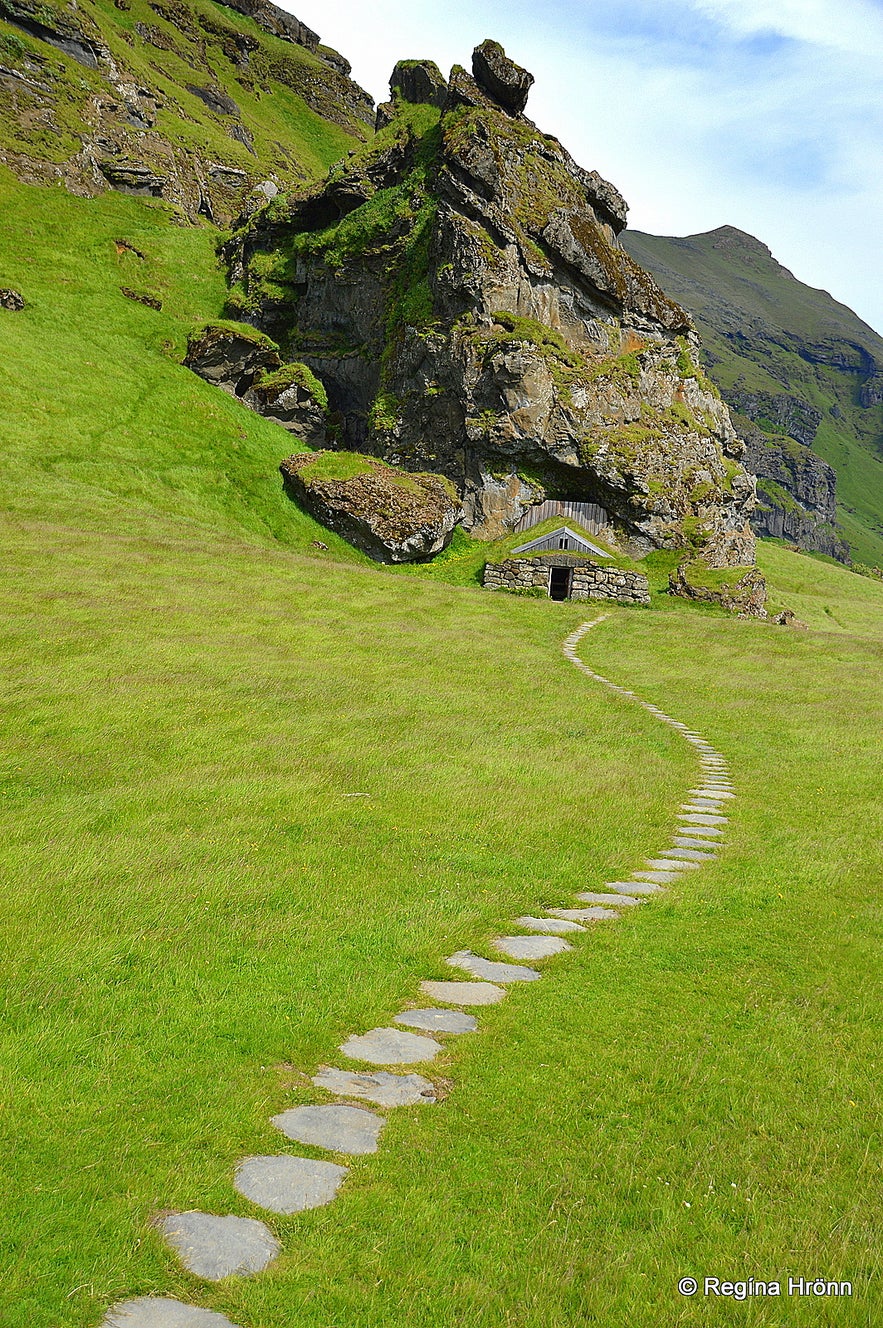
Rútshellir cave in 2020
I wrote a travel-blog about Rútshellir cave many years ago but deleted it recently when I saw how many people were visiting it. I don't think it can withstand too much traffic. Then I reposted it when I saw the new improvements by the cave: The Peculiar Rútshellir Cave in South Iceland
Ref: Manngerðir hellar á Íslandi by Árni Hjartarson, Guðmund J. Guðmundsson og Hallgerður Gísladóttir
Borgarvirki - was this a Viking Fortress?
Borgarvirki and the information sign
On the Vatnsnes peninsula in North-West Iceland, you will find what we like to believe is a Viking fortress from the 11th century, called Borgarvirki - the Citadel. Borgarvirki is a volcanic plug, which forms a natural fortress of basalt columns, to which the Vikings then added.
Old folklore tells us that the Vikings used Borgarvirki for Viking military purposes, but we cannot find the source in the Sagas. So this might be a lost story from the Heiðarvígasaga.
The fortress is 177 meters above sea level and 10-15 meters high. The people of this area seem to have used Borgarvirki as a fortress when they were under attack from the chieftains of Borgarfjörður in the 11th century.
Entering Borgarvirki
The opponent's strategy was to starve the locals out. The locals had run out of food during one of the attacks and overheard the attackers talking amongst themselves about how much provision the Húnavatn's locals had left.
Their leader, Víga-Barði, came up with a strategy to get rid of the attackers. Provisions were running out, and only one piece of meat was left. Víga-Barði had his people throw that piece of meat out of the fortress, giving the attackers the idea that they had plenty of provisions left.
In this natural fortress, you will find lading, which has been rebuilt and is declared protected.
Borgarvirki
Find out more in my travel-blog on Borgarvirki Fortress in North-West Iceland - a Viking Fortress.
To reach Borgarvirki turn off ring-road 1 onto road 711. Then turn left on 717, which is 8 km of a bad one-lane road with hard shoulders and several blind hills. Include the Hvítserkur monolith in your visit.
The Lair of the outlawed Viking Grettir the Strong
Visiting Grettisbæli lair
Hidden away up in the screes of Mt. Öxarnúpur in North-East Iceland you will find the Viking lair of the outlawed Viking Grettir sterki Ásmundarson - Grettir the Strong (approx. 996). His saga is told in Grettissaga - the Saga of Grettir.
Grettir is amongst other things famous for having been an outlaw for almost 20 years, which seems to have been the maximum penalty for outlaws.
Grettir was killed on Drangey island only a couple of months before he would have regained his freedom.
On the way to Grettisbæli lair
The so-called Grettisbæli - the Lairs of Grettir can be found in several locations around Iceland. I found one of his lairs hidden away in the 146 m high basalt column mountain, Öxarnúpur, in Öxarfjörður fjord.
To reach the lair, you will have to hike up some scree to the top of a protruding rock. Once you have reached your destination on the rock, you will see a small lawn and the lair. This stronghold of Grettir the Strong is small, the height and width are only 1 meter, and the length is around 3 meters. It was probably well insulated by Grettir.
The lair is half-covered with five heavy basalt columns, which form a roof over the lair, one of which is broken. Only Grettir the Strong could have covered his lair with such heavy basalt columns. What a lonesome and hunted life Grettir, who was afraid of the dark, must have lived here.
My husband at the Grettisbæli lair
Having read the Saga of Grettir in college, an reread it a couple of more times, I think it is pretty cool to be able to visit one of his lairs hidden away up in a mountain.
I have visited two more of his lairs, on Drangey island nd the one at Vígabjarg rock in the Jökulsárgljúfur canyon.
I have written another travel-blog about the Lair of the Viking Grettir the Strong in Öxarnúpur in North-East Iceland with many more photos and directions. And, I recently wrote about more of his lairs: Grettir the Strong and Grettisbæli Lair in Hítardalur Valley in West Iceland.
Bjarnargarður Wall - Remains of an 11th-century turf wall
Walking on the Bjarnargarður wall
Remains of an 11th - 12th-century turf wall can still be seen in South Iceland. It is called Bjarnagarður - the Wall of Bjarni and is one of the biggest preserved man-made structures from the Viking times in Iceland.
It is written in the Icelandic law book from 1281, Jónsbók - the Book of Jón that everybody should build a wall around their hayfield. The wall was presumably erected to protect the pastures legally and to keep farm animals inside.
The 8-10 km long wall was built around the year 1200 and has collapsed through the ages, but parts of it are still visible - I am walking inside parts of the wall in my photo above. I think the original wall would have been my height when it was still standing.
The ash bunker
Hörður, the owner of the farm Efri-Vík and Hotel Laki has dug a bunker through a part of the remains of Bjarnagarður wall, and inside the bunker, we can see the different layers of ash from volcanic eruptions
Hörður has also erected a replica of the Bjarnagarður wall in front of the Bunker of ash layers. It is 50 meters long and gives us an idea of how massive this wall was.

By the replica of Bjarnagarður - here you see how tall it was - not that I am tall though, only 1.66 m, but my ancestors were smaller
Hörður calls this wall Mórallinn or the Guilty conscience, and you can read in my travel-blog Hotel Laki and its Amazing Surroundings in South Iceland how that name came about.
Sources: Hörður Davíðsson at Efri-Vík
Þingvellir National Park - the Viking Parliament - a UNESCO site
Almannagjá at Þingvellir
Þingvellir was the ultimate Viking place, as here the Vikings from all around Iceland gathered for two weeks every summer for their parliament, Alþingi, which they founded in 930.
Alþingi operated at Þingvellir until 1798 and Þingvellir is a very sacred place to us Icelanders.
The Icelandic flag in my photo below marks what we like to believe is the spot where Lögberg - Law Rock was located.
Lögberg at Þingvellir National Park
Unfortunately, there is not much to show for it, and not many Viking ruins of camps have been discovered.
Parts of stone and turf ruins of some 50 booths have been found, mainly from the 17th and 18th centuries, but most of the Viking booths are not visible.
Snorrabúð - the booth of the Chieftain Snorri goði, is believed to be next to the Law Rock.

Snorrabúð booth
And Njálsbúð - the Booth of Njáll is on the west bank of the river, opposite Þingvallabær residence, while Biskupabúð - the Booth of the Bishops is north of the church.
You can walk on Búðaslóð path and read about the booths and see what they might have looked like back then if you scan a QR code on your mobile phone.
What the booths might have looked like at Þingvellir - screenshot from my phone
I wish we could see the ancient booths as they were back then - I would f.ex. love to see the booth of Egill Skallagrímsson of the Saga of Egill.
It is quite an experience though exploring Þingvellir and imagining what it must have been like when the Vikings convened in this location.
 Búðaslóð path
Búðaslóð path
But it is a bitter-sweet experience, as so many people were executed at Þingvellir.
There were no executions here in the Viking time though, as punishments back then were performed in the home districts.
The punishments at Þingvellir started in the latter part of the 13th century.
Flosagjá at Þingvellir National Park
At Þingvellir the assembly set laws and disputes were settled and here the Lawspeaker was the main authority.
He was appointed for 3 years at a time and a part of his role was to read out loud from Lögberg - Law Rock 1/3 of the laws each year - until they were written down.
The noted Snorri Sturluson and his nephew Sturla Þórðarson of the Clan of the Sturlungar were Lawspeakers at Þingvellir at some point.
Icelandic Vikings from all over Iceland got to meet at Þingvellir, and some love affairs started here, f.ex. between Gunnar at Hlíðarendi and Hallgerður langbrók from the Saga of Njáll.
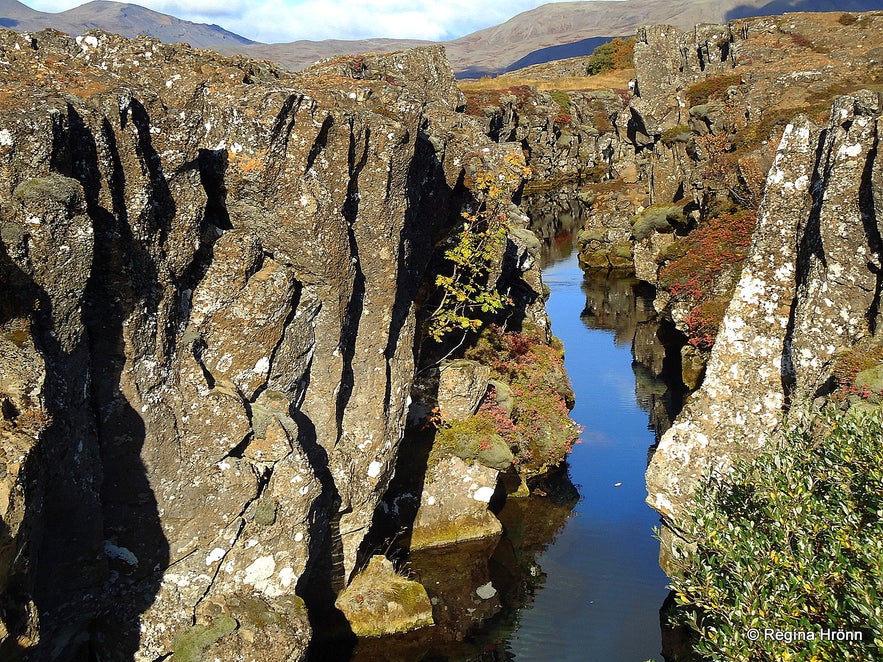
Nikulásargjá at Þingvellir National Park
Þingvellir is situated in an active seismic zone and here the tectonic plates are visible above ground, which adds to the experience of visiting this historic place. The valley has sunk some 3-4 meters since the Vikings were here, and it moves apart some 2 cm each year.
Þingvellir is declared protected and a UNESCO Viking site since 2004. Visit the website of Þingvellir National Park for more information.
The distance to Þingvellir from Reykjavík is only 50 km and it is part of the Golden Circle.
Krakalækjarþing assembly in East-Iceland
Krakalækjarþing ruins
In East Iceland, you can visit the ruins of Krakalækjarþing assembly on Þinghöfði cape. Krakalækjarþing assembly is mentioned in chapter 4 in Droplaugarsona Saga.
It was one of 3 spring assemblies in East Iceland. These spring assemblies were held for 4-7 days in May from 930-1262.
All in all, there were 13 assemblies in Iceland; 3 in the East, West, and South, but 4 in the North. East assembly had 3 Chieftains - so Iceland had 39 Chieftains, sometimes more.
The information sign at Krakalækjarþing
There was also an autumn assembly at Krakalækjarþing, which was held after the annual summer assembly at Þingvellir, where the Vikings gathered for 2 weeks in June for a general assembly. At the autumn assembly, changes in laws made at Þingvellir were announced.
Ruins of 20 booths and other structures can be seen at the old assembly site and when you walk around this area you will see many ruins covered by moss and vegetation.
Krakalækjarþing ruins
Krakalækjarþing got its name from the wealthy Kraki, who lived at the old farm Krakalækur. His daughter, Helga, was said to be the best and fairest of all the women in Fljótsdalshérað.
Krakalækjarþing assembly is by road 925.
Kirkjuvogur at Hafnir in SW-Iceland - ruins of a Viking longhouse
Ruins of a Viking longhouse at Hafnir
At Kirkjuvogur at Hafnir on the Reykjanes peninsula in SW-Iceland, a Viking longhouse was discovered in 2003. The ruins are next to the Kirkuvogskirkja church at Hafnir.
The longhouse is 18 meters long and 8 meters wide.
The ruins date back to before the year 900 and they might be the ruins of the settler of this area Herjólfur Báðarson, a relative of the first settler of Iceland, Ingólfur Arnarson, who gave him this land.
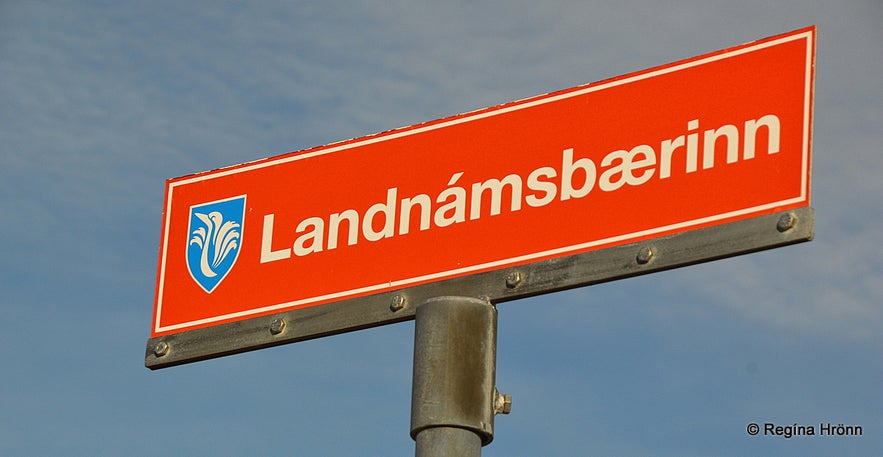
The sign for Landnámsbærinn - the Settlement Farm at Kirkjuvogur (Vogur)
In chapter 35 in Landnáma - our book of Settlement is written: "Herjólfur hét maður Bárðarson, Herjólfssonar, frændi Ingólfs landnámamanns. Þeim Herjólfi gaf Ingólfur land á milli vogs og Reykjaness".
Ólafsdalur valley archaeological site in W-Iceland
The ruins in Ólafsdalur
At Ólafsdalur in West Iceland, ruins of a Viking longhouse were discovered in 2018. It is believed that they date back to the 9th or 10th century.
I walked from the Ólafsdalur old agricultural school to the archaeological site to check it out. I recommend visiting this valley on your way to the Westfjords of Iceland. It is well worth it and only a short detour from road 60.
You can follow the archaeological procedure on their Facebook page: Fornleifarannsóknir í Ólafsdal.
A pagan temple at Úthlíð
The ruins at Úthlíð
At Úthlíð upcountry in South Iceland, a pagan temple was built around the year 900. The ruins can still be seen, but they are not well-marked so it took me a while to find out where they were located.
Usually, such sites are marked with the yellow sign "Friðlýstar minjar", but there was no sign anywhere to be found. I visited them in 2020 and searched for them for the longest time and I gather that they can be seen at the front in my photo above.
Archaeological excavations at Stöð in Stöðvarfjörður East Iceland
The ruins at Stöð
A couple of Viking Longhouses have been found in Stöðvarfjörður at Stöð in East Iceland, one on top of another. I visited the archaeological site twice in the summer of 2020.
The older ruins at Stöð seem to date back to 860-870 or even earlier, so they predate the Settlement of Iceland. It might have been a seasonal hunting camp and a harpoon was found in the ruins.
 The archaeological site at Stöð
The archaeological site at Stöð
Here at Stöð, the largest Viking longhouse in Iceland has been discovered, it is almost 44 meters long!
Here at Stöð rich people have lived and a myriad of pearls have been found - we are talking about some 190 pearls! Several Arabian silver coins have also been found.
On my second visit to Stöð in September 2020, the archaeological remains had been covered up with tires.
The archaeological site at Árbær in Reykjavík
At Árbæjarsafn Museum in Reykjavík, excavations have unearthed the ruins of walls of outhouses of the Árbær farmstead dating back to 1226.
Excavations are still underway and artifacts from many periods have been unearthed. This is the easiest archaeological site to visit, so I recommend a visit to the Árbæjarsafn open-air museum. There you will also see a turf house and a turf church.
Geirsstaðir in Hróarstunga East-Iceland
Geirsstaðakirkja church - a hypothesis turf church
At Geirsstaðir in Hróarstunga in East Iceland, a Viking longhouse; a manor, and a church were discovered in 1997. The church was most likely erected around 1000.
A hypothesis turf church was built in 1999-2001 at Geirsstaðir, in the liking of the ruins of the church unearthed.
Þórssteinn rock at Þórsnes
Þórssteinn at Þingvellir
In the 10th chapter of Eyrbyggja Saga is written: "There is yet to be seen the Doom-ring, where men were doomed to the sacrifice. In that ring stands the stone of Thor over which those men were broken who were sacrificed, and the colour of the blood on that stone is yet to be seen."
In the summer of 2020, I visited the Þórssteinn rock at the old Þórsnessþing quarter parliament at Þingvellir on the Þórsnes peninsula - close to Stykkishólmur village on the Snæfellsnes peninsula.
This area was settled by Þórólfur mostrarskegg who established the Þórsnessþing district parliament. It was first located by Hofstaðavogur (Hofsvogur) close by, but after a battle (approx. 932-934) caused by where the toilets (for nr. 2) should be, the parliament ground was desecrated by blood and was moved to this location.
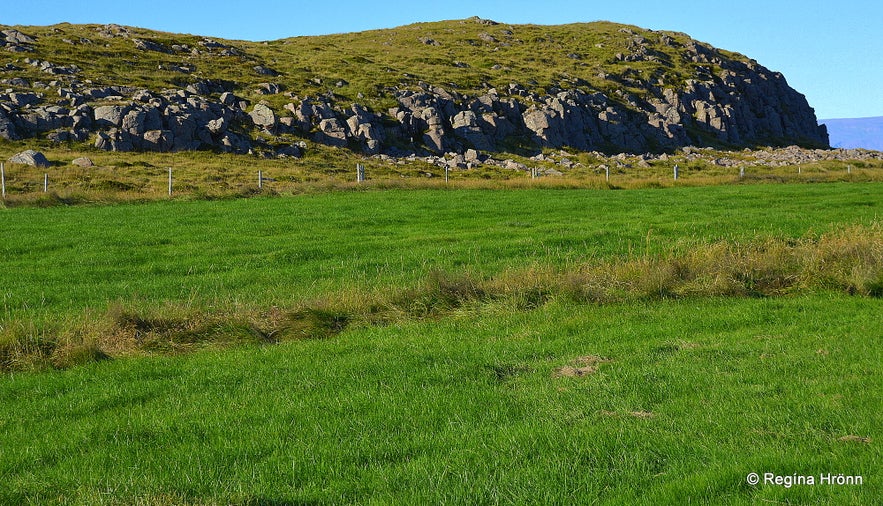
It is believed that the parliament was here at Þingvellir - the rock is called Þingvallaborg
By that time Þorsteinn þorskabítur at Helgafell, the son of Þórólfur mostrarskegg held the chieftainship.
I recommend reading Eyrbyggja, it is an excellent source about this area.
Another interesting site is close by where you will find a burial mound of two Berserks.
Húshólmi on the Reykjanesskagi peninsula - in the middle of a lava field
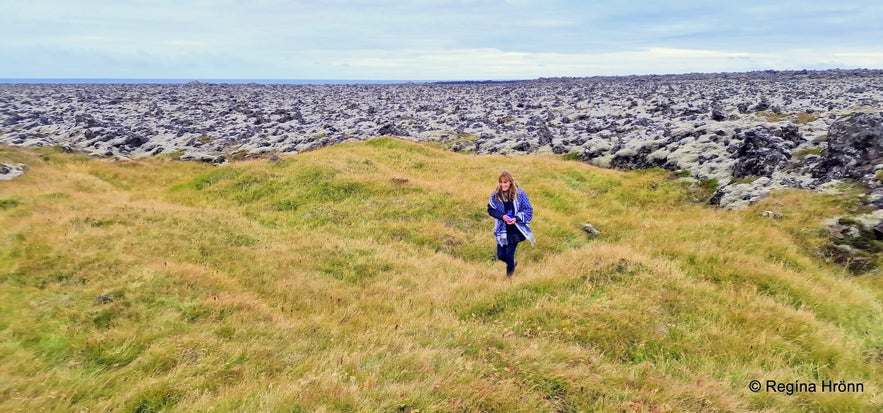 Ruins of a church and a longhouse at Húshólmi
Ruins of a church and a longhouse at Húshólmi
At Húshólmi on the Reykjanesskagi peninsula in the old Krýsuvík, ruins of a church and a longhouse that might be from the early settlement of Iceland can be found in the middle of the Ögmundarhraun lava field.
And an old wall from the same period. It is approximately 150 cm wide and 40 cm tall.
Here the lava flowed in around 1151 and mysteriously spared a longhouse and the church. There are several ruins in this area and it is believed that some of them are under the lava field.
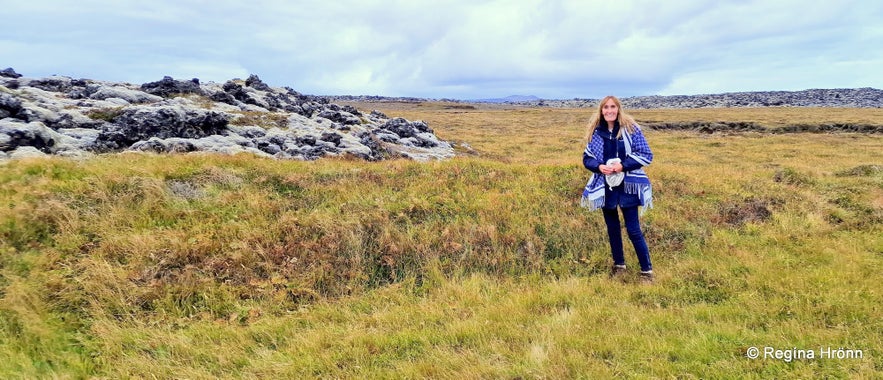 By the old wall from the early settlement age
By the old wall from the early settlement age
We don't know anything about the people who lived in this place, but specialists believe that the ruins predate the settlement (871).
It is an interesting area to visit. You walk through the lava field on the Húshólmastígur path and the hike to Húshólmi and Kirkjulágar is approx. 1.2 km.
The hike seemed much longer though as we were always stopping by some other ruins in the lava field before we reached Húshólmi.
The eruption that created the Ögmundarhraun lava field is called Krýsuvíkureldar.
In the same series of eruptions Kapelluhraun lava field was created, about which I have written in another travel-blog: Barbörukapella - the Chapel of St. Barbara in Kapelluhraun
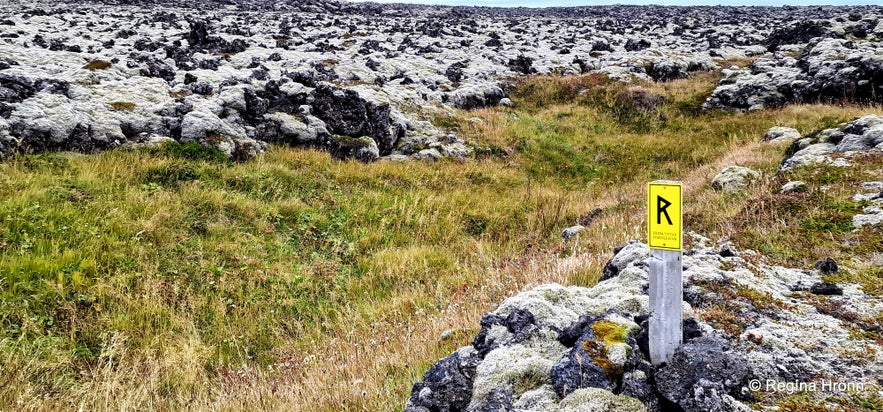 The ruins are marked with the yellow sign
The ruins are marked with the yellow sign
I know of 2 other cases where the lava flow spared the churches; in Reykjahlíð at Mývatn in Mývatnseldar volcanic eruption in 1724-1729 and the Skaftáreldar volcanic eruption in 1783 in Kirkjubæjarklaustur.
Auðkúla archaeological site in Arnarfjörður in the Westfjords
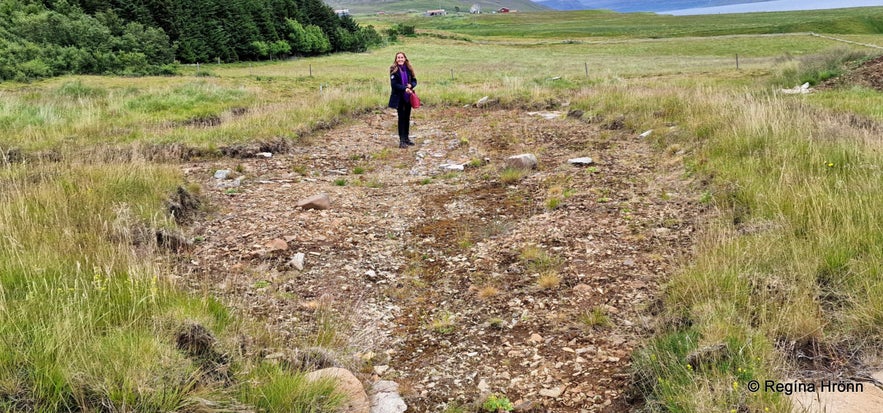 Auðkúla archaeological excavations - the longhouse - I am pointing at the longfire
Auðkúla archaeological excavations - the longhouse - I am pointing at the longfire
I got special permission to have a look at the excavations at Auðkúla in Arnarfjörður in the Westfjords.
In 2013, a large Viking longhouse was discovered here at Auðkúla.
It is 23 meters long and 7 meters wide.
The archaeologists also discovered the largest byre ever examined in Iceland, 22 meters long, so it could have housed around 40 cattle!
Some wealthy people seem to have settled Auðkúla, as many pearls were found in the longhouse.
Some other Viking ruins in Iceland which I have not yet visited
Friðlýstar minjar - this yellow sign from the Director of the National Museum of Iceland indicates preserved relics
There are so many archaeological sites and burial mounds in Iceland that I have only managed to visit a fraction of them. But this long travel-blog of mine is an ongoing process and I will add to it when I visit new sites.
At Öndverðareyri on the Snæfellsnes peninsula, ruins of a Viking longhouse from the Settlement age have been discovered. We visited this site in the summer of 2020, but only saw the newer ruins.

At Öndverðareyri in Snæfellsnes
At Hrísbrú in Mosfell in SW-Iceland a longhouse from around the Settlement of Iceland has been discovered. And a church from around 1000.
The Saga of Egill tells us that Grim of Mosfell built a church at Hrísbrú around the year 1000.
It was demolished when a church was built at Mosfell. Under the altar of the old church, some big human bones were found, which people believed were the bones of Egill Skallagrímsson himself.

Another sign indicating preserved relics - I saw this one together with a yellow one at Djáknadys in East Iceland
At Þórarinsstaðir in East Iceland remains from an early Christian church were unearthed during excavations. Only a couple of such churches have been found.
At Glaumbær in Skagafjörður, ruins of a 33 m x 8 m Viking longhouse were discovered, some 150 meters from the current turf house. I have visited the turf house on many occasions but have never seen the archaeological site.
At Hrafnseyri in Arnarfjörður fjord in the Westfjords of Iceland, a Viking longhouse has been discovered. It is 23 meters long.
Ruins of 14 convents have also been discovered in Iceland:
Bæjarklaustur, Þingeyraklaustur, Munkaþverárklaustur, Hítardalsklaustur, Flateyjarklaustur, Helgafellsklaustur, Þykkvabæjarklaustur, Kirkjubæjarklaustur, Keldnaklaustur, Saurbæjarklaustur, Viðeyjarklaustur, Möðruvallaklaustur, Reynistaðarklaustur and Skriðuklaustur.
I have visited many of these ruins but will not be including them here as they are not ruins from the Viking time.
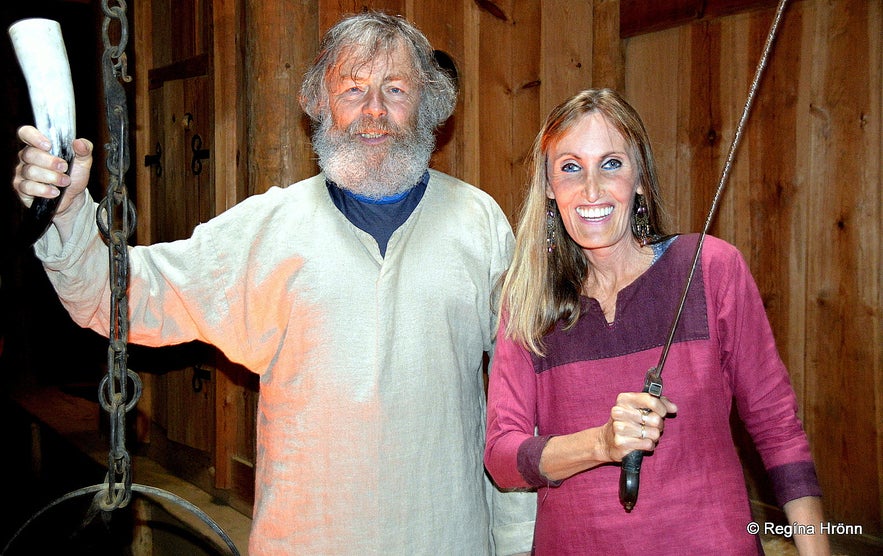
Inside Þjóðveldisbærinn in Þjórsárdalur in 2020
When I first started writing about archaeological sites and burial mounds in Iceland, this travel-blog was of average length, but I have been adding to it for many years now, and it has turned into a monstrous travel-blog.
So I cut out the burial mounds' section and created a new travel-blog where I list the burial mounds only, and leave this travel-blog for archaeological sites: the Ancient Viking burial mound that I have visited on my travels in Iceland.
I have also written a travel-blog about Viking activities in Iceland: The Icelandic Vikings - a List of Viking Activities in Iceland today, which I have joined and am always adding to that list as well.
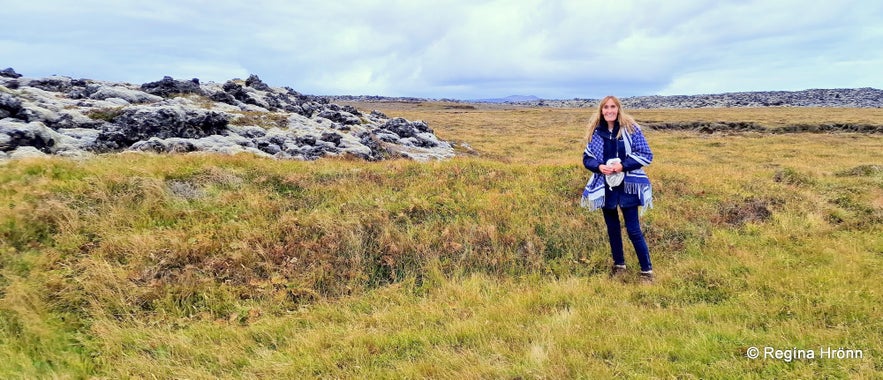 This is not a complete list of Viking ruins in Iceland, only the ruins I have visited on my travels in my country.
This is not a complete list of Viking ruins in Iceland, only the ruins I have visited on my travels in my country.
I am just a layman travelling around my country, showing you the places I have visited, but I hope that this list of Viking ruins proves to be helpful to you during your Iceland visit, and will, hopefully, enrich your visit.
If you are interested in this part of Iceland's history, then also check out the Ancient Viking burial mounds that I have visited on my travels in Iceland.
Have a lovely time in Iceland :)
Ref.: Friðlýsingaskrá Minjastofnunar
Kuml og haugfé úr heiðnum sið á Íslandi, Kristján Eldjárn
Þjóðminjasafnið - The National Museum of Iceland
Mannvist - Sýnisbók íslenskra fornminja
Manngerðir hellar á Íslandi by Árni Hjartarson, Guðmund J. Guðmundsson og Hallgerður Gísladóttir
Information signs at the sites

